Gwendolyn Collaço
Sumptuous holdings of the imperial treasury at Topkapı Palace in Istanbul have overwhelmingly shaped the history of Ottoman art collecting. There, among many objects, luxurious albums of sultans and their highest-ranking officials still reside today. Yet numerous and scattered compilations of works bought from the Ottoman bazaar or market outside the palace walls serve as evidence for a different history of conspicuous consumption.[1] Urban elites collected bazaar paintings alongside more esteemed forms of art like calligraphy, as well as specimens from foreign lands and the Ottoman past, giving albums a status akin to portable Kunstkammers in the eager eyes of enthusiasts. A small trilogy of albums housed at the Bibliothèque nationale de France (hereafter BnF), catalogued as Arabe 6075, 6076, and 6077, offers compelling glimpses into the non-royal practice of compilation in Istanbul and the overlooked Ottoman collectors who sustained the capital’s art market.[2]
Single-folio paintings often known through “costume albums” bought by Europeans also survive in urban Ottoman anthologies (mecmuas) and albums (muraqqas). Although early European buyers denigrated these works for possessing “no art therein,”[3] local Ottomans granted bazaar paintings a much warmer response. That appeal increased particularly in the late seventeenth and eighteenth centuries when market paintings evolved to embody a diversifying corpus in composition, style, and subject matter. In his seminal work on earlier Persian albums, David Roxburgh described them as “inherently private objects” that constituted sites for the preservation and display of art.[4] In that regard, the following essay explores this set of BnF albums as an intimate mirror of their creator’s world.
Within humble eighteenth-century bindings, the BnF’s trilogy of albums contain a mix of Ottoman portraits alongside a number of foreign counterparts from Safavid Iran and Mughal India spanning over two centuries. An owner once bought these paintings on the urban art market and carefully arranged them into facing pairs. The resulting compendium attested to some of the eclectic tastes in painting among urban collectors. Only individual paintings in the albums have received passing mentions in studies and fleeting references in surveys, but the trilogy has not received substantial analysis.[5] However, the albums as a cohesive set offer a rare chance to examine the work of a non-royal compiler who organized these disparate paintings into a unique compilation of characters that inhabited the popular stories and political scene of late eighteenth-century Istanbul.[6] After tracing the collector’s urbanite background through a codicological analysis of the albums, this essay explores their compilations, which expertly drew together numerous provenances and techniques of execution. The trilogy sheds light on a dynamic market for single-figure painting where our compiler readily sought out these works. In addition, the range of depictions within the albums demonstrates the transformation of urban painting from its mid-seventeenth-century incarnation, formerly dominated by spare, decontextualized figures from the city and palace. Instead, a mix of experimental scenes unfolded by the late eighteenth century, defined by the expanding tastes of buyers. As we shall see, while still producing single-page studies of urban figures, eighteenth-century artists enhanced this genre to capture multiple modes of portraiture that one could find for sale in Istanbul, including high-end works by court painters and foreign artists, refurbished paintings, and finally original creations of cosmopolitan artists.
The essay then investigates the themes across these albums as a window into their compiler’s urban knowledge base of popular culture that permeated Istanbul’s homes and the public spaces of its literati. Despite the lack of information about the original owner, the albums divulge substantial clues as to the stories that entertained him, current political figures that intrigued him, and opposing forces at play in his social landscape.[7] In that regard, the essay considers how albums craft meaning and identities from initially anonymous paintings.[8] By deftly manipulating the gutter of the page, each bifolio opening becomes a self-contained narrative. Guided by sparse but effective inscriptions, a viewer could easily gauge the narratives invoked within these albums through its selection of characters. As a curator in his own right, the owner not only gave these codices specificity though the medium of an album, but also declared their devotion to the dynamic political and literary world of Istanbul through his evocative inscriptions.
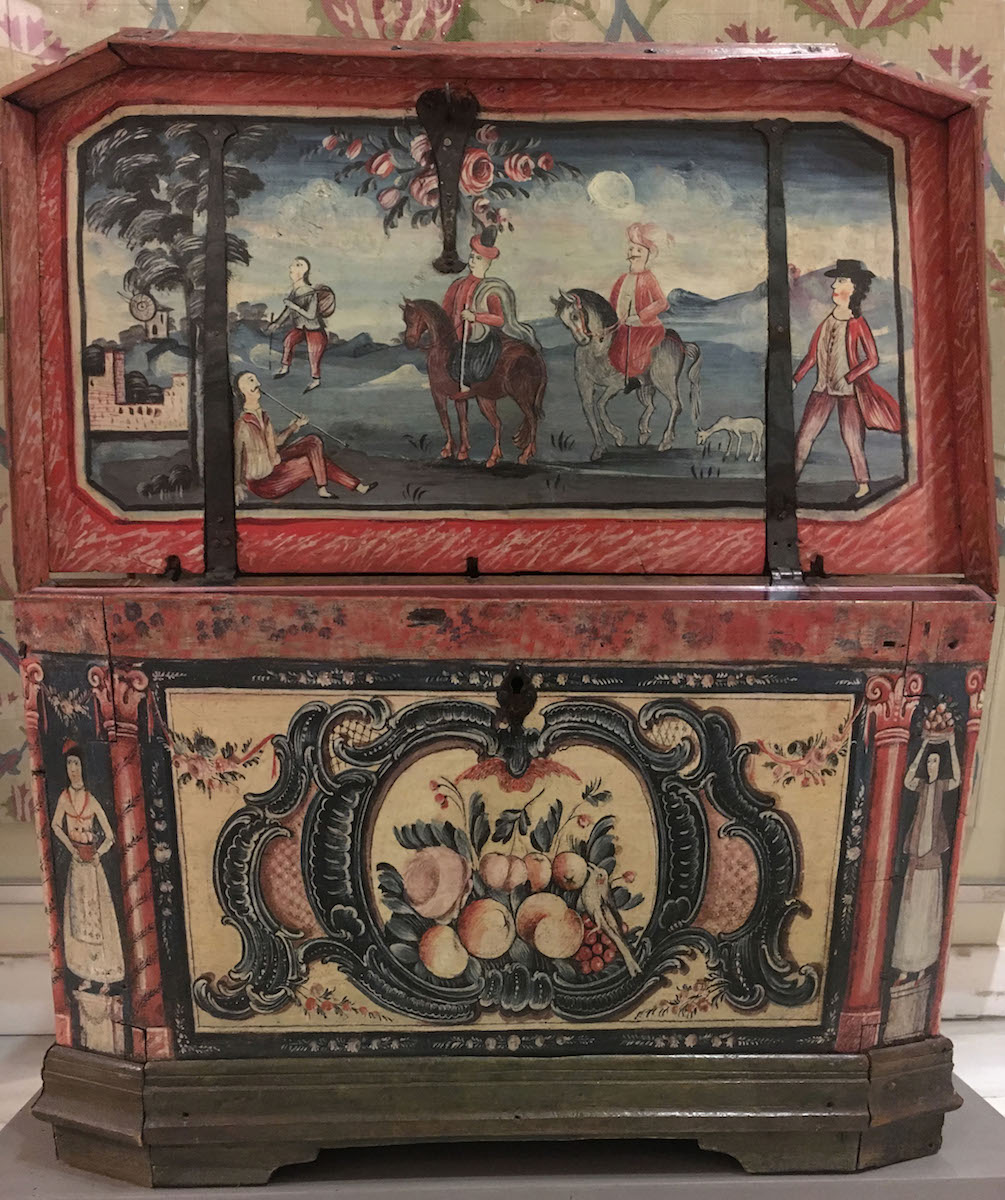
Fig. 1. Maker(s) unknown, Painted chest, late 18th century. Wood and gouache, 55 x 85 x 45 cm. Benaki Museum, Athens, 37951. © Benaki Museum.
Eighteenth-century Istanbul was a world of conspicuous consumption where affluent individuals could curate their material goods into expressions of their social, cultural, and political identities.[9] Within this community, collectors of paintings and illustrated manuscripts formed an elite circle of buyers.[10] According to surviving evidence, urbanites such as wealthy merchants and local notables from the capital to regional cities covered their walls with landscapes, bountiful depictions of fruits, and musical instruments,[11] even furnishing their rooms with large painted chests depicting narrative scenes and costumed figures (Fig. 1). Albums belong to that social milieu and were equally driven by environments of display. That is to say, the consumerism and consumption of art embodied in the form of an album offered a space to fashion one’s self-identity in a curated display of material wealth.[12] Indeed these albums paint, as it were, a portrait of an individual as a cosmopolitan collector and an avid follower of the urban literati.
Studies of Ottoman painting and albums based on royal commissions provide limited means to reconstruct urban practices of collecting from the open market.[13] The BnF trilogy of albums presents an opportunity to discuss not only the existence of a thriving market for paintings, but also the exchanges that took place between the palace and the city in the eighteenth century. Throughout these albums, as I will demonstrate, the interactions between court and public, as well as tradition and innovation, vividly play out. The albums also compel us to question some long-held assumptions about the artistic capabilities of so-called bazaar artists. Featured paintings by these artists, made for a non-royal clientele, widen our understanding of their development beyond the better-studied costume albums bought by foreigners and the occasional, if not pro forma, festival gift to the sultan.[14] Moreover, the trilogy provides ample opportunity to complicate the Westernization narrative of Ottoman painting from the late seventeenth to eighteenth centuries, which marked the decline of Ottoman court production.[15] Although the court atelier (nakkāşhāne) certainly shrank during this century and half to a fraction of its original size,[16] the gradual transformation enabled another category of artists to emerge who incorporated inspiration from a plethora of visual and cultural sources. Likewise, the market allowed the works of court artists to reach a wider base of patrons than previous periods in Ottoman history. In a broader sense, this Ottoman case study contributes to an increasingly global understanding of the commercial art market during the long eighteenth century.[17]
Trappings of a Collection
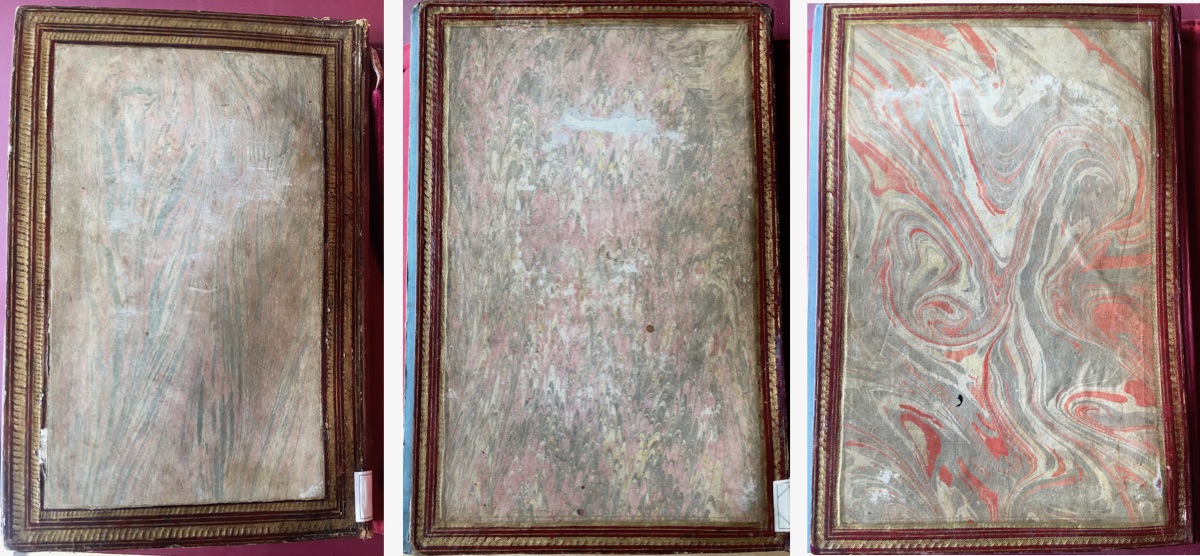
Figs. 2a, 2b, 2c. Anonymous compiler, Covers of titular albums. Leather and marbled paper, 34 x 24 cm each. Bibliothèque national de France, Paris, Arabe 6075, 6076, and 6077. Source gallica.bnf.fr / BnF.
The story of these albums as a trilogy begins with their bindings. Their unassuming exteriors mark the culmination of a process of selection, arrangement, and preservation, realized as a formal collection at a specific point in time. Their material and textual clues frame our understanding of the individual behind this project. Each volume measures thirty-four by twenty-four centimeters and contains 16 folios featuring portraits and scenes mounted individually on marbled and colored papers (Figs. 2a, 2b, 2c). The large drop patterns of the marbled support papers, in addition to the latest datable paintings and character labels, place the time of compilation in the late eighteenth century.[18] Matching Arabic-script notes, written in a separate hand from the painting captions, appear pasted on the first page of each volume and indicate that the paintings were part of three corresponding sets of thirty paintings each.(Fig. 3).[19] Thus an owner or later Ottoman seller considered each codex part of a single collection, as their physical features also suggest.
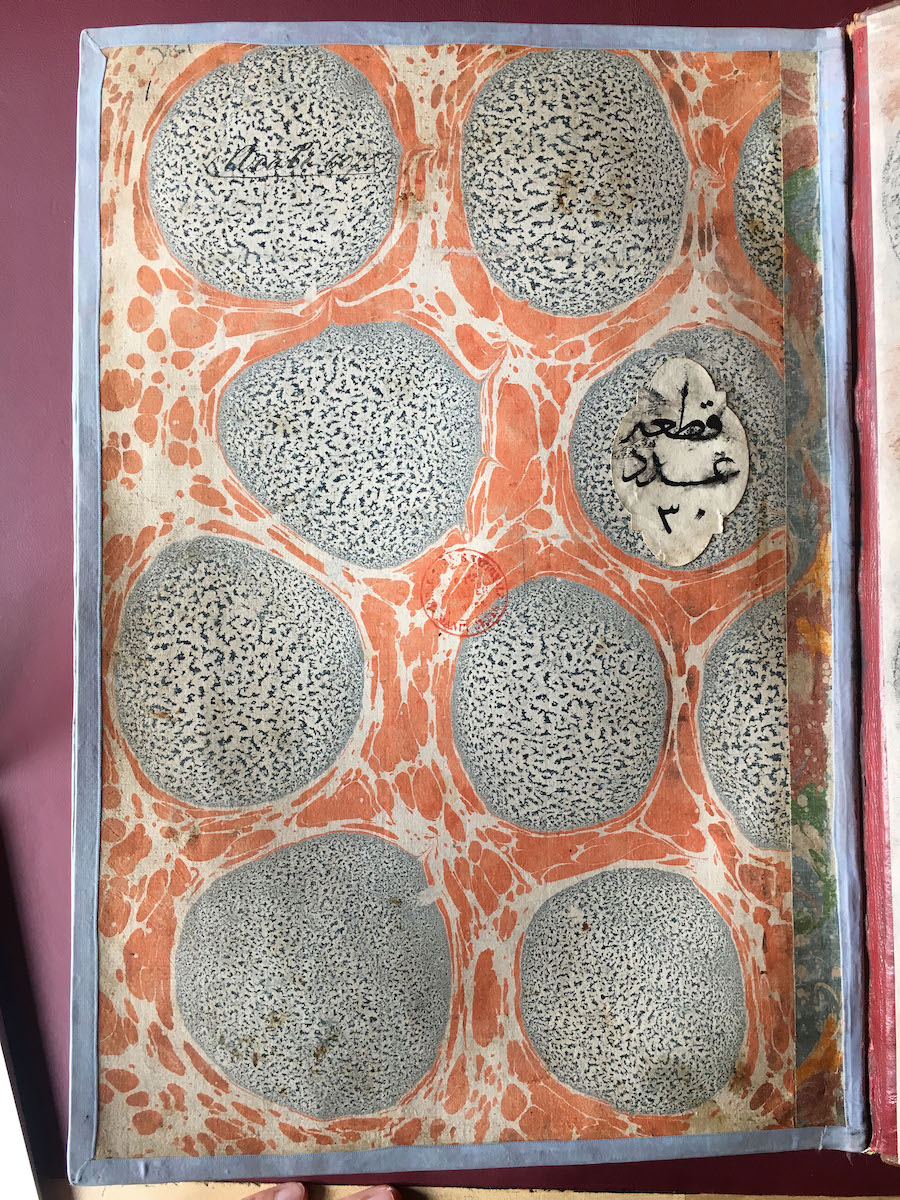
Fig. 3. Maker(s) unknown, Marbled paper and pasted note, late 18th century. Ink and pigment on paper, 34 x 24 cm. Bibliothèque national de France, Paris, Arabe 6075, fol. 1r. Source gallica.bnf.fr / BnF.
Although some of these paintings had previous owners and purposes, in this trilogy, their function became redefined by their physical trappings and the person who arranged them. Their codicological features suggest a buyer with expensive tastes, but somewhat limited resources. The bindings employ a method of construction called “çahârkûşe cild,” a hemmed binding that began appearing in the seventeenth century, coinciding with the rising popularity of the album format in the Ottoman Empire.[20] This technique frames only the edges of cover boards in leather, while the faces and internal pastedowns are lined with cheaper materials like paper, textiles, or another kind of leather[21]—in this case, marbled paper, a popular choice from the reign of Ahmed III (d. 1736) onwards.[22] These types of marbled-face covers depart from contemporary albums preserved in the imperial treasury that use the same technique of hemmed binding, but often feature rich Moroccan leather or lavish textiles interwoven with precious metal-wrapped thread.[23] The sumptuous album (H. 2155) created during the late eighteenth century for Mehmed Efendi, son of the Şeyhülislam, provides illuminating differences afforded to a patron of a higher status (Fig. 4). Within its hemmed edges on a considerably larger frame (45.3 x 30 centimeters), the album’s cover-face showcases a magenta seraser textile imported from Europe, complete with patterns of silver- and gold-wrapped thread.[24] In contrast, the owner of the BnF albums capitalized on the flexibility of hemmed binding to incorporate the economic alternative of marbled paper, a noticeably humbler choice than the costly material favored by high-end buyers like Mehmed Efendi.[25] Based on these factors, it would not be too farfetched to surmise that the owner of the BnF trilogy was not royalty, and likely of a lower rank than the Şeyhülislam’s son. Nonetheless this compiler evidently had enough capital to purchase or inherit a substantial number of impressive paintings. Thus, much like architectural patronage of the period, cultural production, including ownership of paintings and illustrated books, expanded to a slightly wider swathe of society that attracted the likes of urban elites.[26]
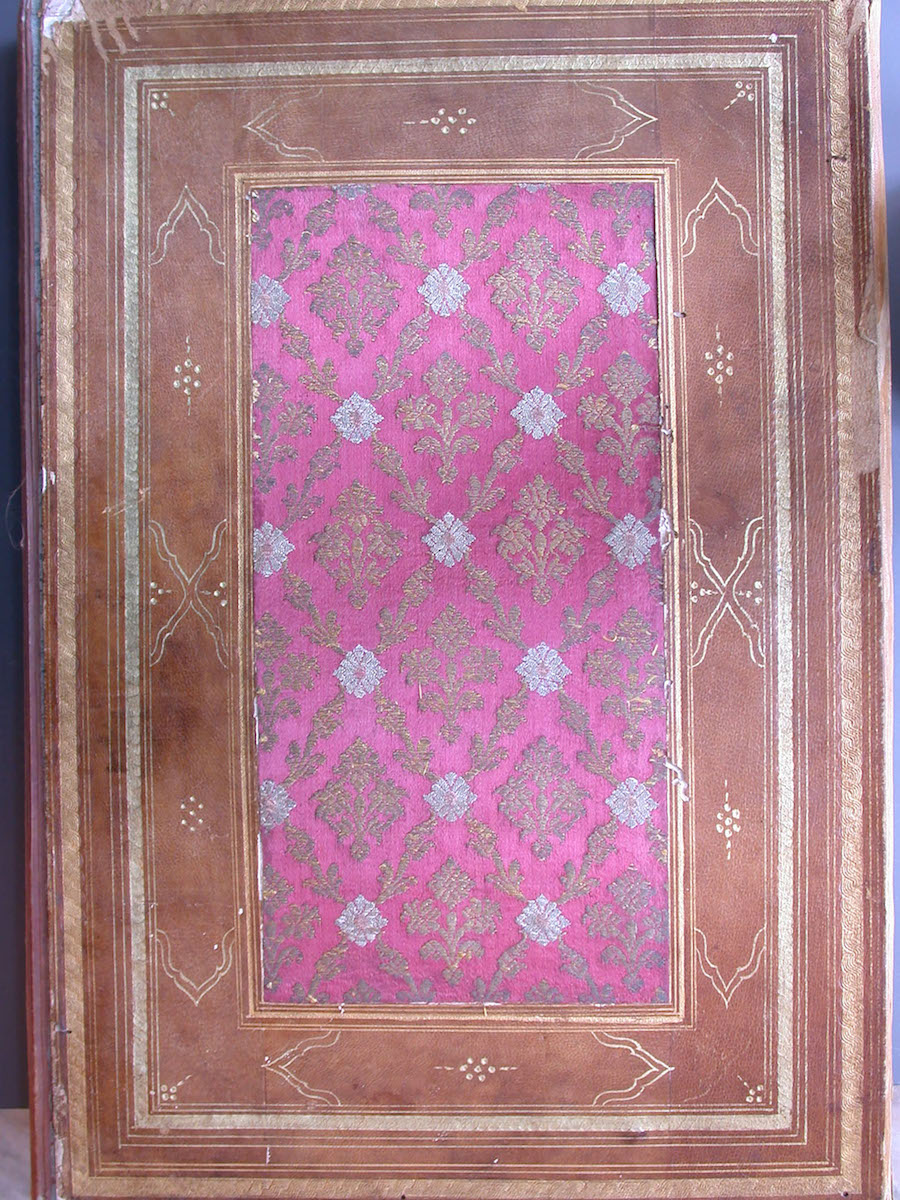
Fig. 4. Maker(s) unknown, Hemmed binding and seraser cover face of Mehmed Efendi’s album. Cloth-of-gold textile and leather, 45.3 x 30 cm. TSMK, Istanbul, H. 2155. Photo courtesy of Topkapı Palace Museum.
Buying Ottoman Paintings in the Late 18th Century
What could a collector buy on the market in Istanbul? How did the album maker or compiler come across these works? What kind of knowledge did someone outside of the palace have to identify different techniques and characteristics of paintings sold in the city? The BnF trilogy gives one set of possible answers to these questions. Each volume offers several clusters of themed paintings that include city beauties, courtly figures, Sufis, musicians, and literary characters. Arranged in pairs according to similarities in design, execution, or narrative, the paintings reflect their owner’s discerning eye for a range of techniques and compositional types. Their selection makes an apt guide to some offerings of Ottoman paintings on the open market and our collector’s methods of consumption.
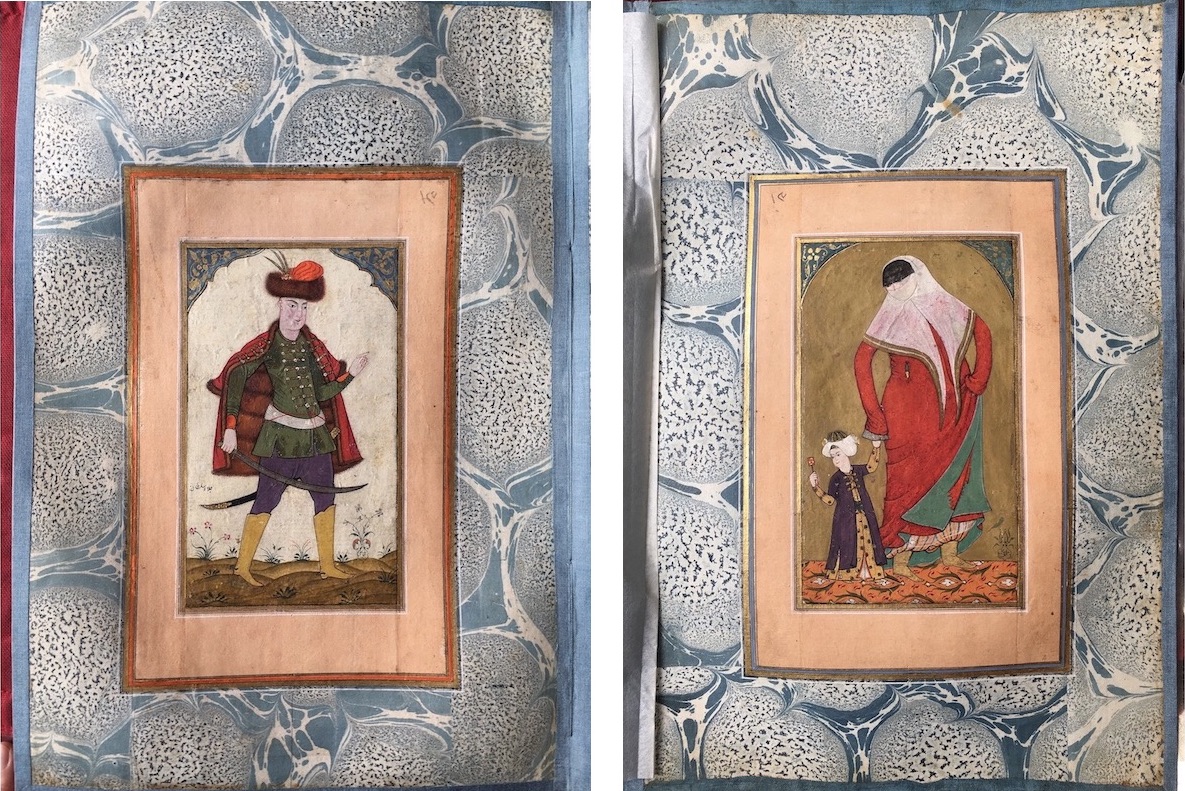
Figs. 5a and 5b. Levni, Cellad-ı Sultan (or sultan’s executioner) and Portrait of a woman outdoors with child, first half of 18th century. Opaque watercolor on paper, 34 x 24 cm. Bibliothèque national de France, Paris, Arabe 6077, fol. 13v-14r. Source gallica.bnf.fr / BnF.
Each album of the BnF trilogy carries works by one of the palace’s most renowned painters of the eighteenth century: Levni (d. 1732), or a close member of his circle. Seven paintings carry Levni’s characteristic signature in a floral cartouche, while several others likely feature his designs (Figs. 5a and 5b). Often, as if in recognition of Levni’s contribution, the compiler carefully arranges these portraits in facing pairs. To echo that connection, the paintings appear mounted in a similar fashion on marbled papers of the same drop-pattern design. The work of another esteemed court artist also graces this trilogy: Abdullah Buhari, whose paintings featuring city beauties in sumptuous garb (Fig. 6) survive in an Istanbul University album (T. 9364) and single-folios at Topkapı Palace (Fig. 7).[27] Although some palace albums by Abdullah Buhari were dispersed following the First World War, little is actually known of non-royal patronage of his works prior to this time.[28] Yet the late eighteenth-century bindings of the trilogy reinforce the likelihood that his works circulated in markets over a century prior to the dispersal of the palace albums. Interestingly, both Levni and later Buhari were among the first pioneers to sign their names on the portraits they painted, adding to their recognizability beyond the court.[29] In the culture of display to which the trilogy’s compiler belonged, the importance of a signature may well have gone beyond recognition to even adding value to the collection and status to its owner, regardless of whether the individual had any strong connection to the court.
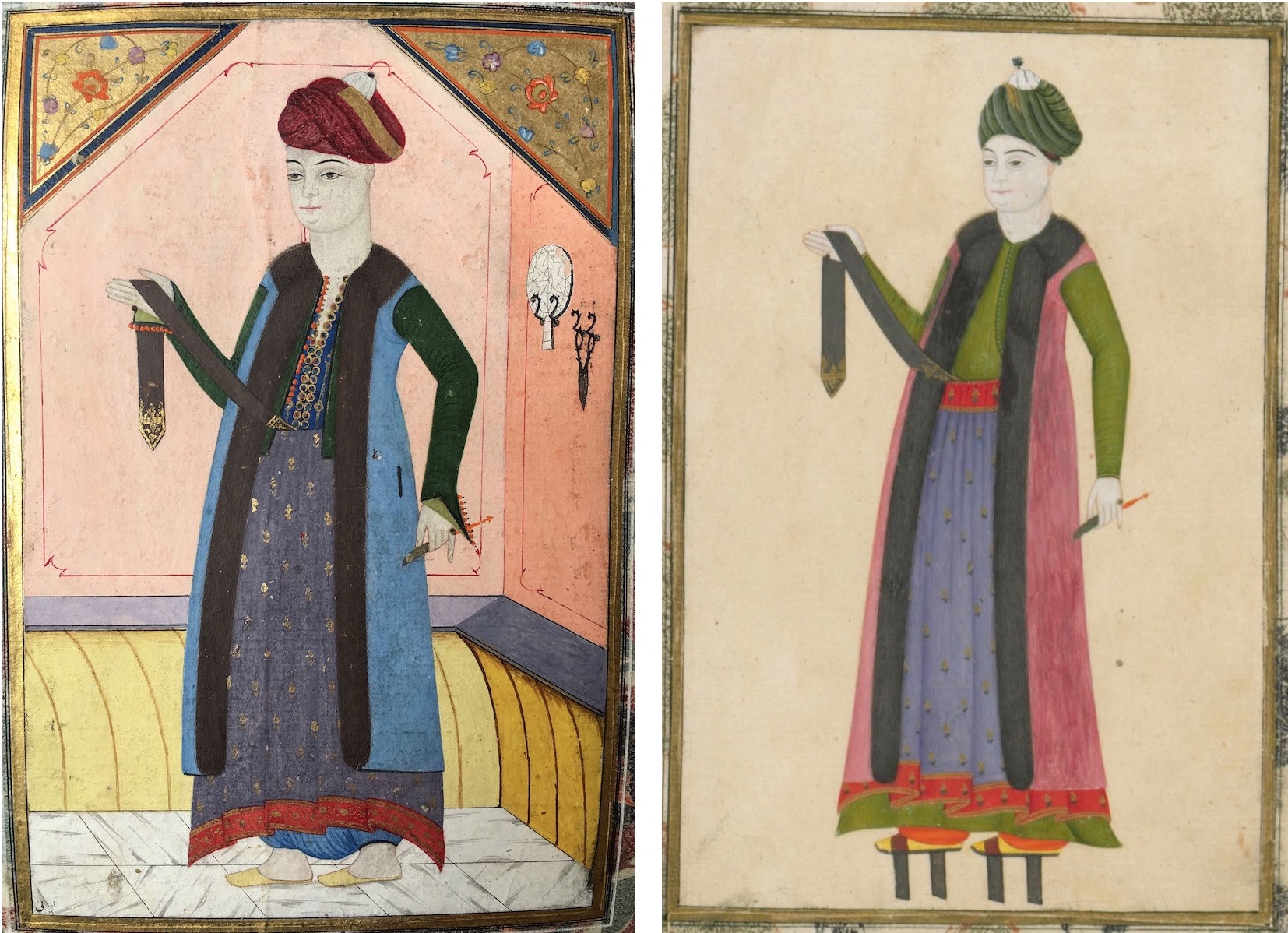
LEFT: Fig. 6. Abdullah Buhari, Portrait of a fashionable gentleman, mid 18th century. Opaque watercolor on paper, 34 x 24 cm. Bibliothèque national de France, Paris, Arabe 6077. fol. 11v. Source gallica.bnf.fr / BnF.
RIGHT: Fig. 7. Abdullah Buhari, Portrait of a gentleman on high pattens, mid 18th century. Opaque watercolor on paper, 10.6 x 16 cm. IUK, Istanbul, T. 9363, fol. 9r. Image courtesy of Istanbul University Library.
Indeed, palace manuscripts had found their way onto the open market since at least the late seventeenth century. During his travels to Istanbul in the 1670s, the bibliophile-orientalist Antoine Galland religiously recorded descriptions and prices of manuscripts for sale in Istanbul. He bemoaned the high prices quoted by booksellers promoting rare books originally (so they said) commissioned by the Sultan.[30] Other royal manuscripts arrived in the bazaar when ambassadors sold off Ottoman diplomatic gifts for cash to cover their living expenses.[31] Additionally, by the late eighteenth century, women from the royal harem traded illustrated manuscripts to outsiders with the help of palace intermediaries.[32] Urbanites could also find illustrated works at estate auctions.[33] In a rare account of this practice, Evliya Çelebi describes a particularly eventful auction in Bitlis (a city in Eastern Anatolia) in 1655-1656 following the expulsion of its Kurdish khan. There, a kadızadeli[34] zealot hijacked an illustrated shahnama (book of kings) at auction, only to destroy its paintings—and the auctioneer’s profit.[35] From that same auction, Evliya described the dispersal of the khan’s “200 remarkable bound albums of Persian and European drawings and paintings.” He writes:
Several thousand products of the magical pens of world-famous artists, both calligraphy and painting, circulated freely in the auction, and passed from hand to hand among all sorts of Kurdish rabble and vermin and unclean Turks. Some pages were so manhandled that they were torn or wrinkled in the process. The auctioneer went from tent to tent, tearing out pages and selling them for a song.[36]
Although Evliya may have exaggerated the numbers, the episode vibrantly depicts how paintings could pass from the hands of local notables to urban buyers and sellers. The frequent probate auctions occurring in the capital provide a tempting possibility for how our eighteenth-century collector obtained paintings dating as early as the late sixteenth century for such a compilation—and likely at an attractive price.[37]
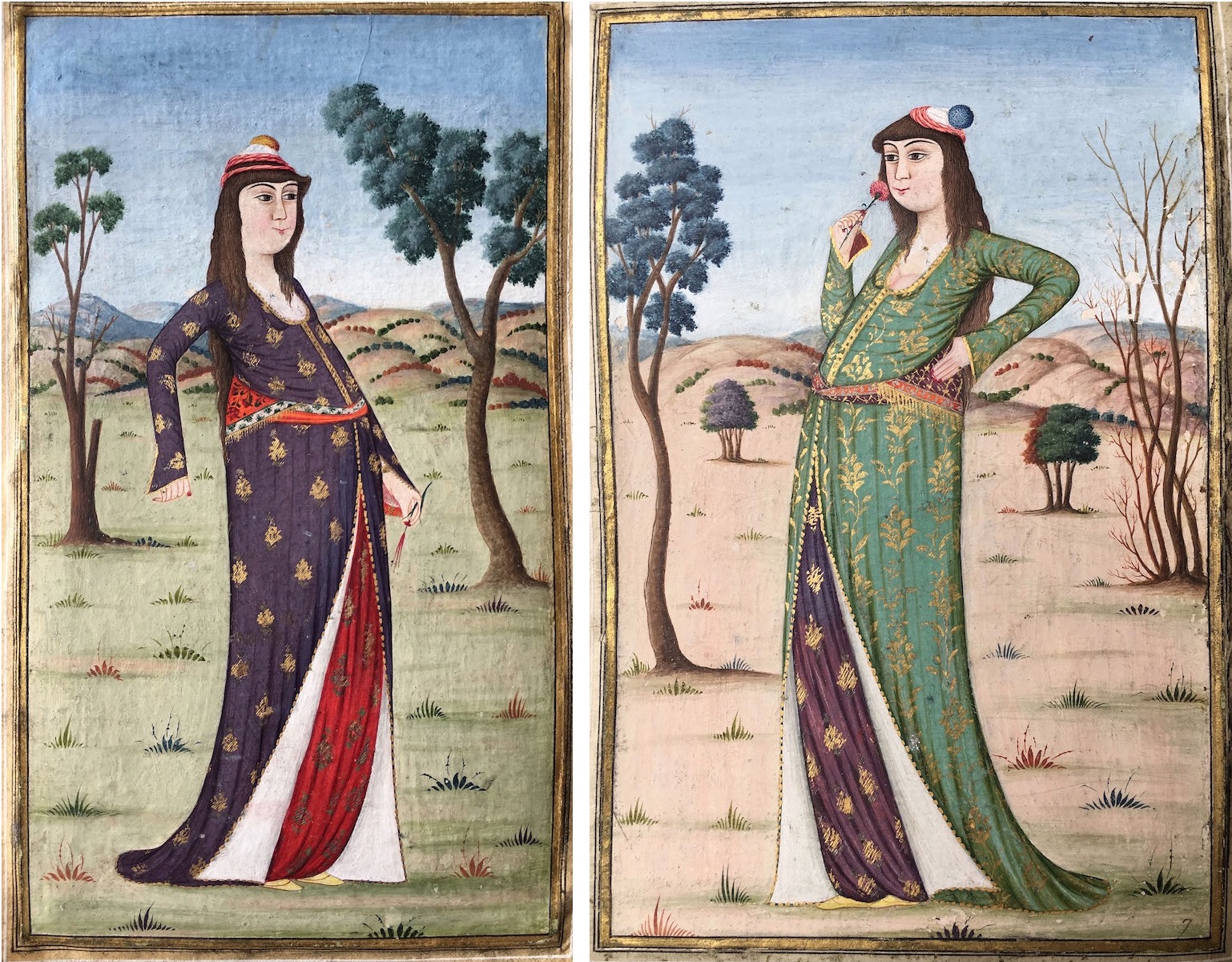
Figs. 8a and 8b. Artist(s) unknown, Portrait of a lady in green and Portrait of a lady in purple, late 18th century. Opaque watercolor on paper, 34 x 24 cm. Bibliothèque national de France, Paris, Arabe 6076, fol. 10v-fol. 11r. Source gallica.bnf.fr / BnF.
Aside from the above-mentioned artists, the BnF albums contain the works of several unnamed cosmopolitan painters who contributed fresh approaches to portraiture. These painters produced single-figure studies of stylish men and women during the mid- to late eighteenth century (Figs. 8a, 8b, 12, and 14). The quality of these works redefined the simpler “costume album” images of the mid-seventeenth century. They drew aspects from both Levni and Buhari in their focus on details of costume, modeling, and drapery. Especially in the blank stares transposed from face to face, and the strong forward curve of their languid poses, these portraits trend more towards the characteristics of Abdullah Buhari’s work. In addition, these urban artists incorporated rich scenic backdrops from nature or decorated interiors seldom found in the costume albums prior to this time, and rare even amongst Buhari’s paintings.
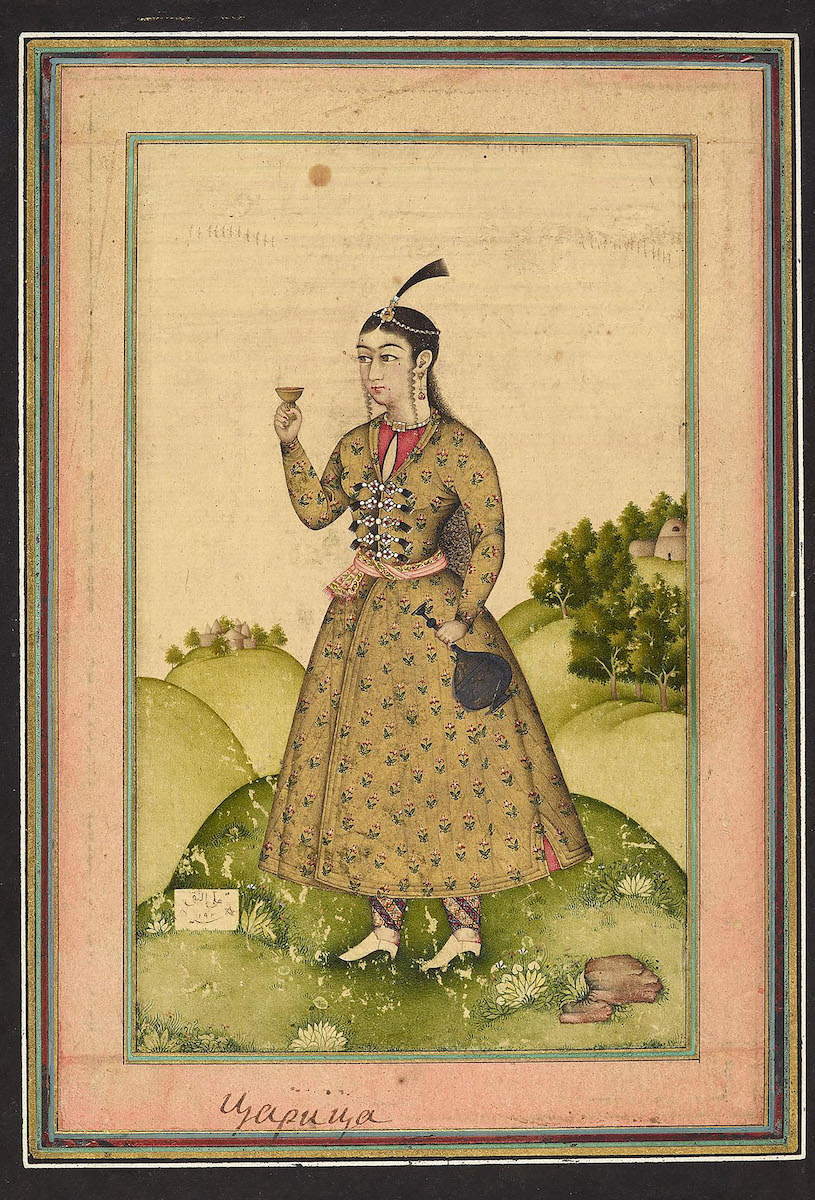
Fig. 9. Ali Naqi, Portrait of an Indian woman holding a cup and decanter, 1681. Opaque watercolor on paper, 14.8 x 8.9 cm. State Hermitage Museum, St. Petersburg, ИС-1146. Source hermitagemuseum.org / The State Hermitage Museum.
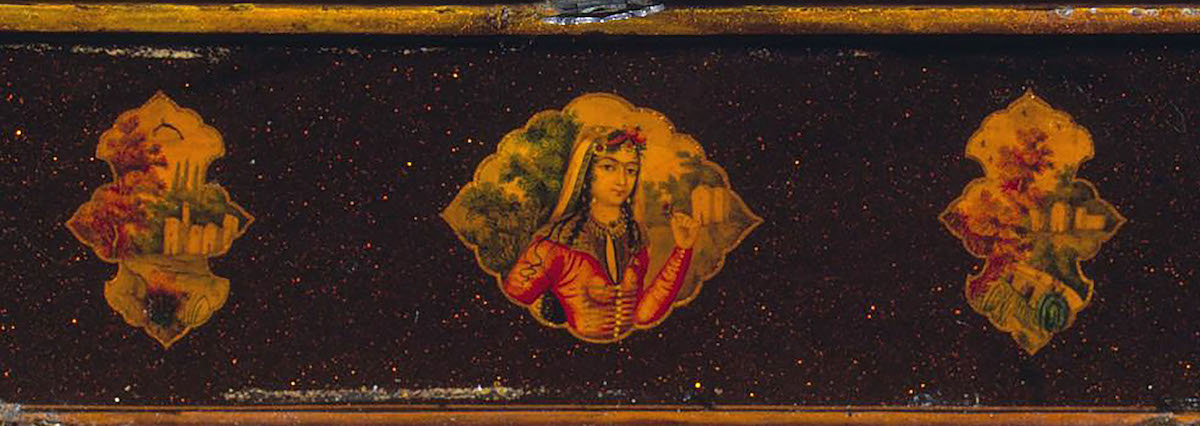
Fig. 10. Muhammad Zaman, Inner folding lid of a qalamdan (pen-case), 1700-1701. Papier-mache and lacquer, 26.9 x 6 x 4.8 cm. State Hermitage Museum, St. Petersburg, VР-126. Source hermitagemuseum.org / The State Hermitage Museum.
The earliest Islamicate comparisons to such scenic portraits appear in the mid-seventeenth-century frescoes of Chihil Sutun Palace in Isfahan as well as Armenian homes in New Julfa, Iran, which likely belonged to merchant families operating trade circuits across Eurasian territories.[38] By the end of that century and through the 1700s, meadow-like backgrounds akin to these portraits accompanied many mobile objects created during the eighteenth century such as qalamdans (pen cases) and paintings from Iran and the Mughal Empire, which travelers, ambassadors, and merchants could easily carry along routes passing through Istanbul (Figs. 9 and 10). For example, early Qajar albums, like one compiled by Sir William Ouseley shortly after the BnF albums in the early nineteenth century, attest to Iranian and Indian works that made their way across Ottoman territories before finding their current home in England.[39] Such circulating works made ideal sources of inspiration and models for artists to translate into an Ottoman idiom as these albums demonstrate, or vice versa. Therefore, the artists of this album tapped into more widespread trends in portraiture, circulating via trade routes between various European polities and the wider Persianate world. Several scholars have also raised the possibility that itinerant Armenian artists spread European elements like landscapes associated with farangi saz (European style) throughout the Persianate world.[40] In their own regional incarnation, by the mid-eighteenth century urban Ottomans began incorporating similar rolling landscapes into their homes. These cases included waterside mansions (yalıs) that extended a trend of landscape frescoes also seen in mosques of the period.[41] Thus these albums responded to a visual culture that permeated media encountered by well-to-do urbanites. Moreover, the prevalence of these approaches to portraiture across empires during this period points to consumers’ broad participation in expanding commercial networks.
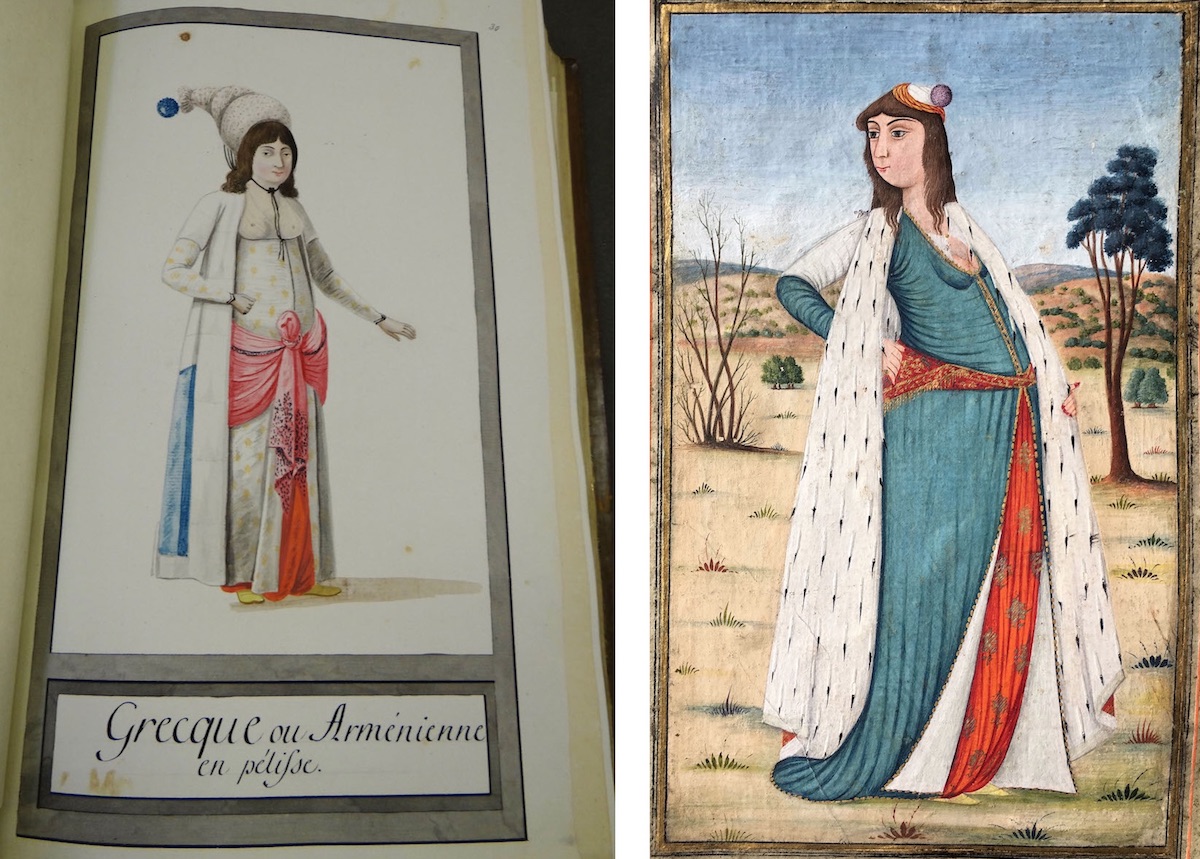
LEFT : Fig. 11. Artist(s) unknown, Grecque ou Arménienne en pelisse, c. 1790. Watercolor on paper, 22x37cm. Heinrich Friedrich von Diez (owner), Costumes Turcs, vol. II, fol. 30r. London, British Museum, 1974,0617,0.12.2.30 © Trustees of the British Museum.
RIGHT: Fig. 12. Artist(s) unknown, Portrait of a lady in ermine, late 18th century. Opaque watercolor on paper, 34 x 24 cm. BnF, Paris, Arabe 6076, fol. 12r.
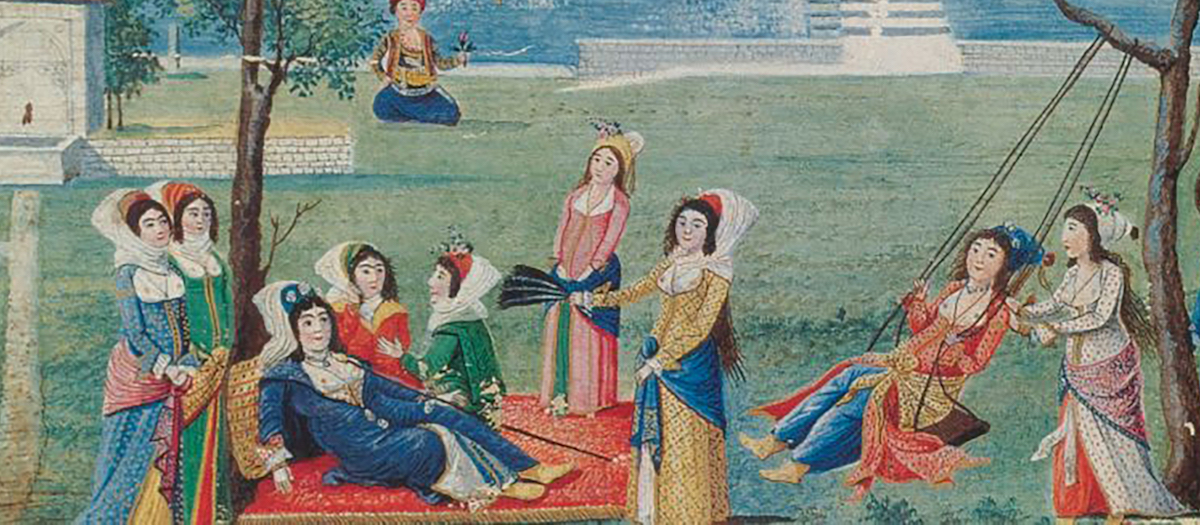
Fig. 13. Artist(s) unknown, Scene of entertainments at Kağıthane from Fazıl Enderūnī’s “Hubanname ve Zenanname,” late 18th century. Opaque watercolor on paper, 13.4 x 24.2 cm. IUK, Istanbul, T. 5502, fol. 78a. Image courtesy of Istanbul University Library.
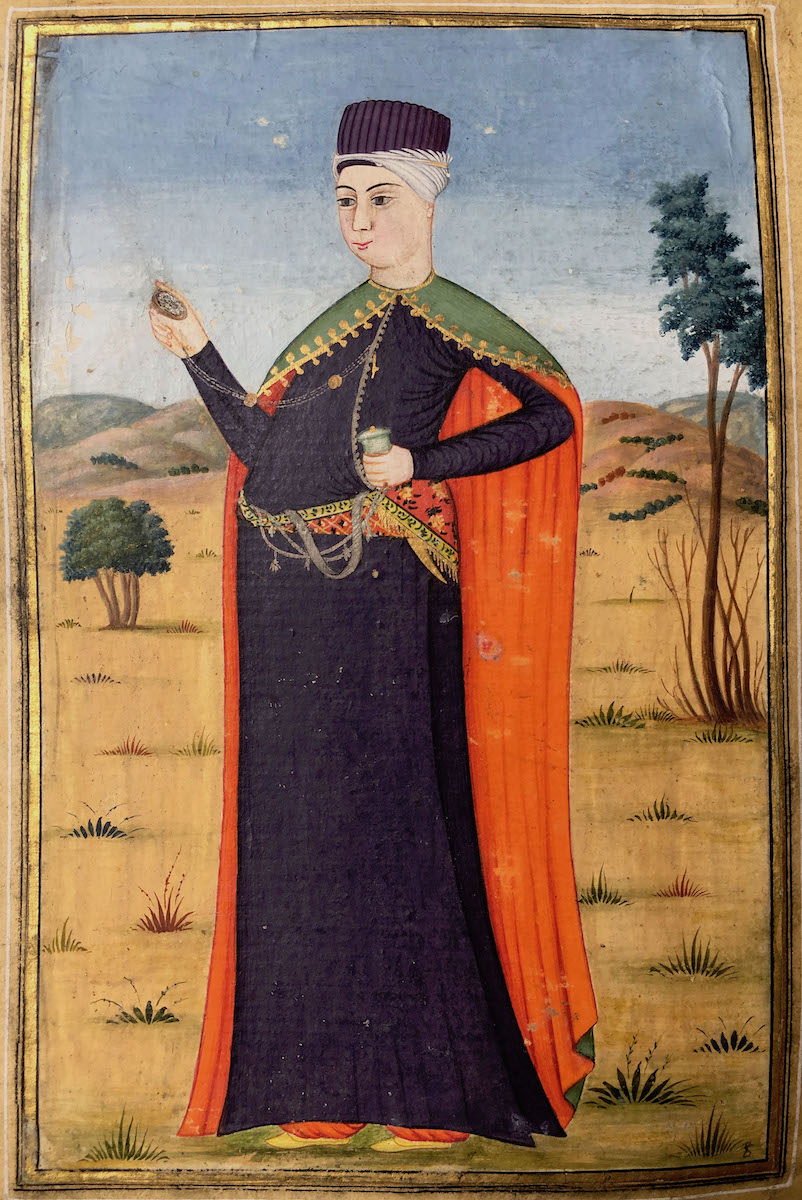
Fig. 14. Artist(s) unknown, Portrait of a young man with a pocket watch, late 18th century. Opaque watercolor on paper, 34x 24 cm. Bibliothèque national de France, Paris Arabe, 6076, fol. 9b. Source gallica.bnf.fr / BnF.
The trilogy’s portraits testify to the luxury products that Ottomans purchased via these trade routes by the late eighteenth century. Multilayered costumes dominate these portraits featuring kaftans of bright lightweight prints, possibly silk-and-cotton blends (karmasüt), available as Indian imports or Ottoman imitations.[42] The abundance of visual data on these costumes suggests the popularity of such trends amongst the commercial elite. The ermine-lined kaftan and entari (dress) on fol. 12r of Arabe 6076 echoes the outfits of numerous women in the so-called Diez costume albums compiled around 1790 (Fig. 11).[43] Other folios in Arabe 6076 also show women in form-fitting entaris, with shawls around their waists, and headdresses topped with large pompoms (Figs. 8a, 8b and 12). Their costumes have direct analogues in the late eighteenth-century Hubanname ve Zenanname (The Book of Men and the Book of Women) by Fazıl Enderūnī (Fig. 13).[44] Furthermore, small details illustrate burgeoning styles that only became widespread during the latter part of the eighteenth century. On fol. 9v of Arabe 6076, an Ottoman youth in fine attire casually holds his pocket watch more to display the trinket than to tell the time (Fig. 14). English clockmakers created such pocket watches for the Ottoman market from the turn of the eighteenth century. Yet only by the later eighteenth century did the use of such watches spread to buyers outside palace ranks.[45] These details not only aid in dating these paintings, they also act as barometers for the changing standards of beauty and fashion. These artists drew inspiration from foreign imports like English-made watches and visual sources that catalogued international modes of dress. Among these sources were costume albums and illustrated works like the Hubanname ve Zenanname, whose images likely relied on circulating fashion prints for foreign models. The resulting portraits take on a hybrid appearance that bear traces of these varied sources.
Urban artists contributed to another painted practice that celebrated the eclectic and experimental nature of the period: overpainting. While the execution in these albums is innovative, the concept of painting refurbishment was not new to Ottoman artists. Members of the royal atelier (nakkaşhane) had often used earlier models for their own works, and also finished incomplete illustrative programs for manuscripts brought to the Ottoman palace, transforming them into a distinctly Ottoman-court aesthetic.[46] Yet the BnF trilogy shows that urban painters interacted with earlier paintings in a highly synergetic way. Later artists inserted scenery into much earlier works previously completed as figural studies on a partial or blank ground, thus contextualizing their subjects. The mixed-perspective end product subsumes the original subject into a study of stylistic juxtaposition. The compiler of these albums highlights several cases of refurbishment in curated bifolio openings, for example fol. 12v-13r of Arabe 6077 (Figs. 15a and 15b).
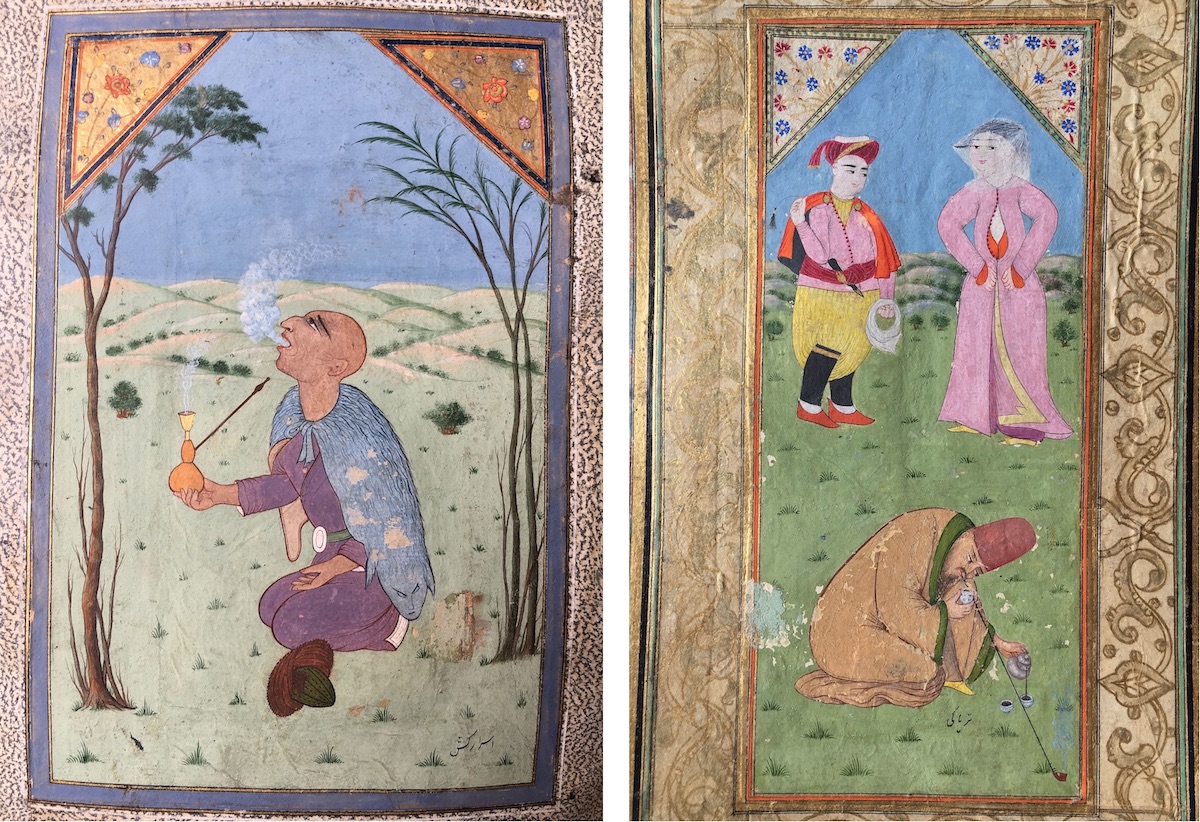
Figs. 15a and 15b. Artist(s) unknown, “Esrarkeş” or a dervish smoking a hookah, late 17th century with late 18th century additions; and “Tiryaki” or an addict indulging in opium and coffee with a couple in the background, early 18th century with late 18th century additions. Opaque watercolor on paper, 34 x 24 cm. Bibliothèque national de France, Paris, Arabe 6077, fol. 12v-13r. Source gallica.bnf.fr / BnF.
Folio 12v captures a dervish smoking a hookah. The portrait has close analogues in a separate BnF album (4-OD-7, fol. 30r and 36r), wherein two portraits of dervishes include similarly slanted eyes, hooked noses, and distinctive wrinkles around their mouths. Additionally, one of the dervishes from 4-OD-7 dons an animal-skin cape that also features a surprisingly expressive look on its anthropomorphized face.[47] The two paintings from 4-OD-7 date to 1688 and were attributed by H.G. Majer to the Ottoman court artist Musavvir Hüseyin (active 1680s-1690s).[48] Assuming that the date is genuine and the attribution is correct, almost 100 years separate these folios. With clearly defined goals to update the image in Arabe 6077, folio 12v’s artist incorporates a receding cluster of hills dotted with stippled trees. The billows of smoke from the dervish’s hookah also reveal fine strokes of shading and highlighting that clash against the burnished color blocks of his skin and robes.
In the painting across from this dervish, a couple undresses for a tryst while a dervish pours coffee and smokes an opium pipe in the foreground. The proportions of the figures and their execution places the work’s creation around the early eighteenth century, comparable to images in the Walters’ Hamse-yi Atayi (c. 1720-1730) and album leaves in Berlin.[49] Yet the landscape upon which this scene unfolds is similarly anachronistic. Patterned rows of stylized grass tufts give way to rolling hills, suddenly more naturalistic, featuring gradient colors of earthy greenery again accented by stippled trees that recede in an abrupt and selective use of perspective characteristic of the late eighteenth century. This particular background closely matches the themes of the album’s late portraits of stylish urbanites, discussed earlier. Yet the contrast between the applications of pigments, the designs of figures, and the treatment of flora in these refurbishments is difficult to overlook. In another striking refurbished painting, the original scenery from the early eighteenth century features a flattened and burnished Persianate rockface, which contrasts the softly shaded, undulating hills added behind it. The opaque shapes of the older rockface remain visible through the slightly transparent pigments of the trees inserted later in the foreground (Fig. 16). The late eighteenth-century artists appear less concerned with making older paintings align with contemporary aesthetics than with creating a perceptible pastiche of styles and a methodical mix of perspectives.
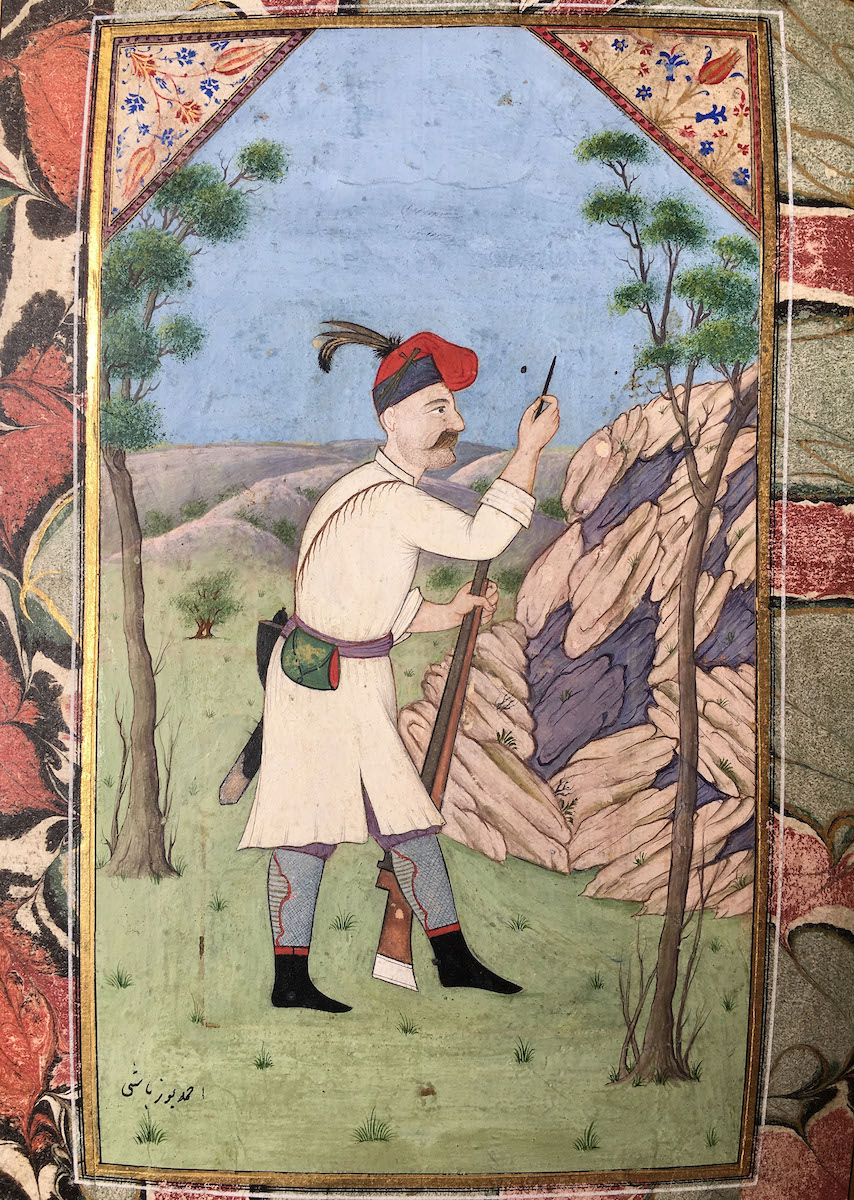
Fig. 16. Artist(s) unknown, “Ahmed Yüzbaşı,” or an Ottoman captain loading his rifle, late 17th century with late 18th century additions. Opaque watercolor on paper, 34 x 24 cm. Bibliothèque national de France, Paris, Arabe 6077, Fol. 9v. Source gallica.bnf.fr / BnF.
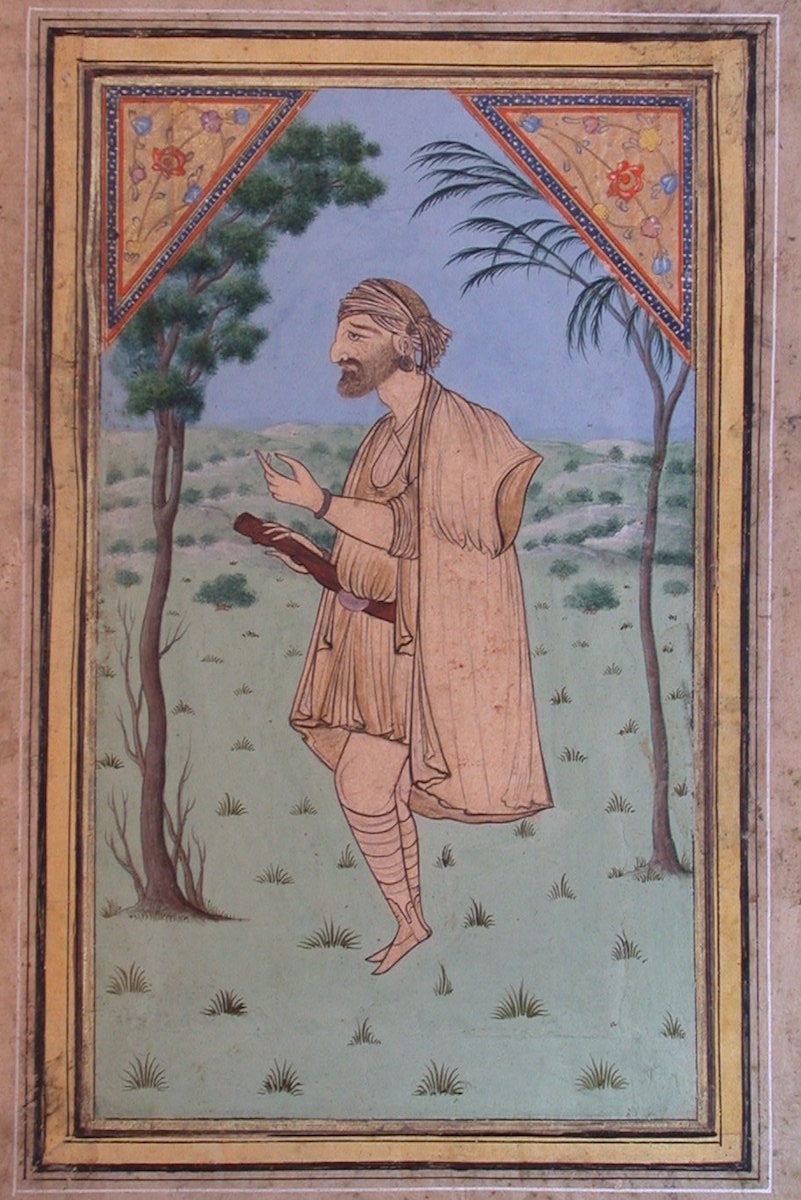
Fig. 17. Artist(s) unknown, Drawing of a dervish, 17th-century Safavid Iran with 18th-century Ottoman additions. Ink and (later) opaque watercolor on paper, 15.8 x 9.1 cm. TSMK, Istanbul, H. 2155, fol. 15v. Photo courtesy of Topkapı Palace Museum.
During this period such artistic interventions were not uncommon. Overt examples of portraits featuring mixes of period styles and updated backgrounds also appear in Mehmed Efendi’s album mentioned earlier (H. 2155) (Fig. 17).[50] Given the similarities in palette, execution, and type of landscape applied here and in the BnF trilogy, artists of the same workshop likely contributed to both albums. However, H. 2155 provides a starker contrast of production elements to contemplate. Instead of a painting, as seen in the BnF albums, the eighteenth-century painter(s) of H. 2155 reclaimed a Safavid pen-and-ink drawing dating to the mid-seventeenth-century and inserted the lush landscape of rounded hills in thicker pigments.[51] The deliberate preservation of the original pen-and-ink drawing at the heart of the composition suggests that the aesthetic these artists aimed to achieve was eclecticism itself. Therefore, cases from the BnF trilogy and the Mehmed Efendi album complicate notions of authorship and originality even during a period when some paintings bear signatures or attributions to esteemed artists. These pieces unabashedly declare themselves the work of multiple hands and generations by juxtaposing styles, using older pieces to distinguish the work of later artists in the process.
In a broader sense, the BnF albums and H.2155 offer a striking counterpoint to most album paintings of the period through their use of an overt visual dialogue between traditional and modern aesthetic sensibilities. While many examples from other albums show how artists visibly copied and transferred designs from earlier artworks, the final physical product largely remained the labor of the current workshop or artist.[52] To purposefully integrate and co-opt an earlier painted piece into a later work made a statement—or more fittingly, a perceivable discourse—that became the new alter-subject of the portrait. In a sense, the project takes the aggregate themes of album-making and applies it to a smaller scale in a single-folio painting. By selectively overpainting several works in this trilogy, this group of artists generated a visual dialogue with their predecessors to create an innovative final product. Their work resonates with concurrent activities in other arts. Seen especially in divan poetry and architecture, the concept of naẓīre or parallel response drove numerous creative endeavors to express originality through a mix of juxtaposition with and emulation of the past.[53]
The Compiler’s Popular Literary Imagination
The compiler’s inscriptions allowed these portraits to assume roles and contexts not initially bestowed by the artists, but later imposed by their context and placement within the album. Unfortunately, our compiler did not include a preface to elucidate his process in selecting these works, further differentiating his practice from palace traditions of compilation.[54] However, his inscriptions speak volumes as to the imagined narratives crafted through this collection. Labels on the majority of these paintings identify characters from literature and figures of contemporary Ottoman history. By highlighting a small selection of these narratives, this essay offers a few of the major transformations that shaped popular culture during this period. As the subjects discussed in the whispers of city gossips and storytellers’ repertoires, these characters engaged concepts of novelty and tradition in late eighteenth-century society.
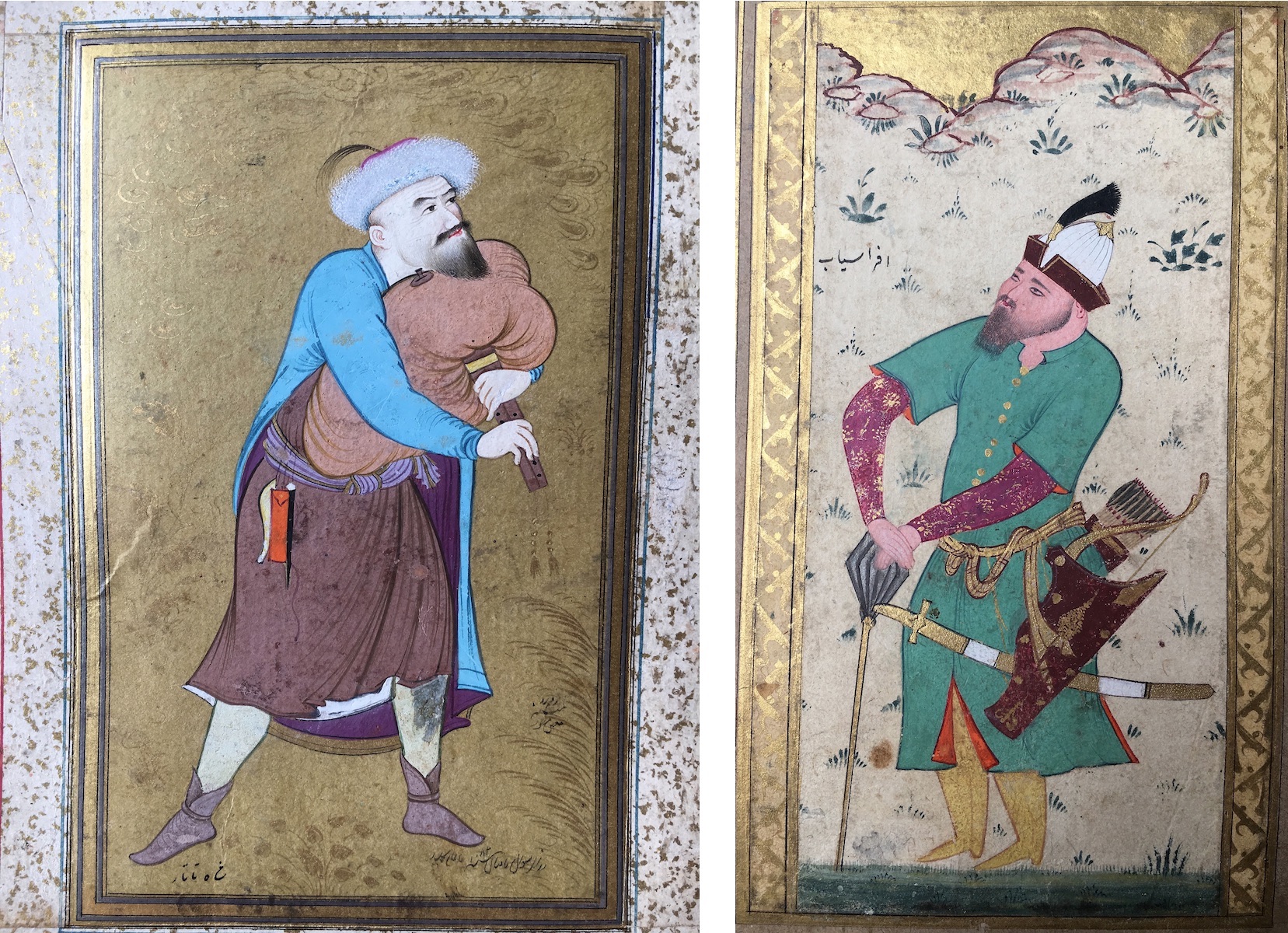
Figs. 18a and 18b. Artist(s) unknown, “Afrasiyab,” mid 16th century; and Muin Musavvir, “Shah-ı Tatar,” mid 17th century. Opaque watercolor on paper, 34 x 24 cm. Bibliothèque national de France, Paris, Arabe 6075, fol. 7v-8r. Source gallica.bnf.fr / BnF.
Old literary favorites clearly still had a place in the late eighteenth-century repertoire, as several openings feature key characters from earlier romances and epics. For instance, the lovers Khusraw and Shirin from Nizami’s Khamsa (completed 1202) make an appearance in Arabe 6075 in the form of mid-seventeenth century single-figure portraits from Iran. The same album also introduces two figures labeled as Turanian antagonists from the Shahnama’s Epic of Siyavash (c. 1010) who waged war against Iran: Afrasiyab and the Tatar Shah (Barman) (Figs. 18a and 18b). These legendary characters are reimagined as an unexpected pair of foreign portraits: a mid-sixteenth-century archer from Central Asia confronting a bagpiper originally painted by the Safavid artist Muin Musavvir in the mid-seventeenth century. By the eighteenth century, stauncher critics complained of literary enthusiasts who favored these fantastical stories over learned texts, calling them “liars who didn’t read Tabari’s History but the Shahnama and Hamzanama.”[55] Much like the devotees disparaged by that anonymous author, this compiler leaned more towards such popular tales than staunchly religious histories.
Yet most of the stories featured in this trilogy reflect a major shift in urban literature that began in the sixteenth century and culminated around the time of the albums’ compilation. The paintings associated with them relate to seemingly contemporaneous stories of Istanbul. Many of the later portraits discussed above fit the subjects often extolled in the poetic genre of the şehrengiz (city thrillers). Such poems took their listeners on a journey through urban landscapes like Istanbul, praising the qualities of its urban inhabitants, often beautiful young men of the guilds.[56] Moreover, newer narratives captured in this collection, including the romance of Kerem ve Aslı, reflect the changing tastes that emerged from city literature. As Cemal Kafadar has remarked, early modern coffeehouse audiences, perhaps fatigued by retellings of classical tales, embraced fresh works like tales from the meddah (storytellers) and Karagöz (shadow puppetry) that did not necessitate overwrought romantic overtures and hackneyed morals from the traditional Persianate canon.[57]
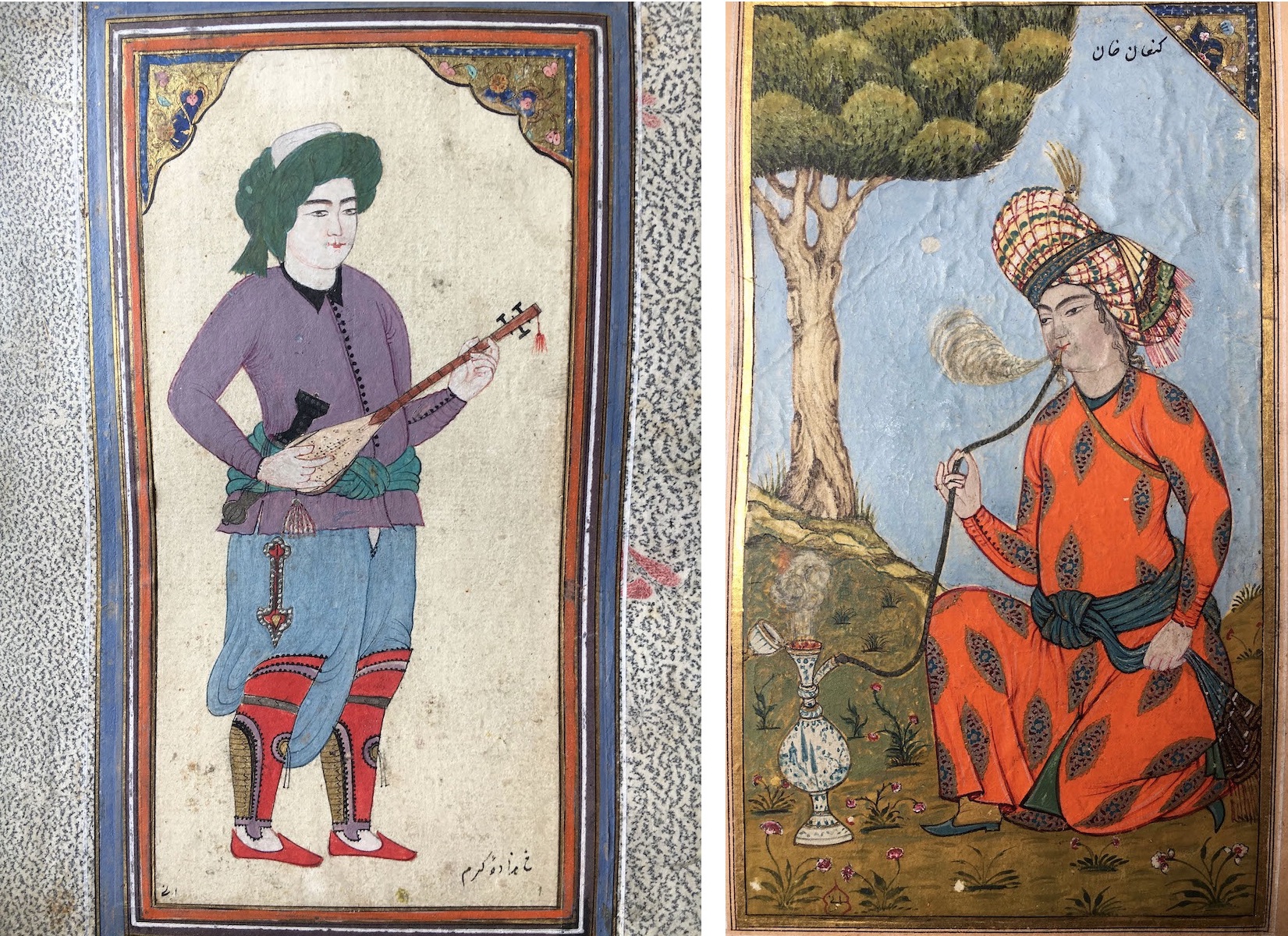
Figs. 19a and 19b. Levni, Şehzade Kerem and Khan of Canaan (“Ken‘an Khan”), first quarter of 18th century with later additions. Opaque watercolor on paper, 34 x 24 cm. Bibliothèque national de France, Paris, Arabe 6075, fol. 15v-16r. Source gallica.bnf.fr / BnF.
In one case from the BnF trilogy, a fictional storyteller becomes the central character of his own literary tale. In Arabe 6075, the striking figure of Şehzade Kerem (alternatively Şeyhzade Kerem) wears a distinctive Balkan costume while playing an oud (Figs. 19a and 19b). His narrative survives as a folktale relating how the young prince (sometimes of Iranian origin) falls in love with the Aslı, the daughter of an Armenian monk (or prince). Upon discovering their romance, Aslı’s father steals her away and flees from country to country to evade love-struck Kerem. To consummate his love, Kerem wanders as a bard performing all around Anatolia, the Caucasus, and elsewhere in search of Aslı, until the pair finally wed and die in each other’s arms.[58] Particularly during the wandering that ensues in pursuit of Aslı, Kerem often stops in local coffeehouses singing poems about his beloved, much like the urban storytellers who recited these episodes to Ottoman audiences.[59] Here, Kerem faces Ken‘an Khan, one of the many individuals our hero deceives during his journey.[60] This episodic romance invited multiple localized portrayals that reimagined the story in any locale. The album compiler opted to Ottomanize Kerem by casting a figure in Balkan attire as the love-struck folk hero. Kerem thereby simulates the identity of wandering Ottoman storytellers like ‘Aşıḳ Garib, who gained fame during the seventeenth century as he toured coffeehouses throughout the empire.[61] The transformation demonstrates how an Ottoman compiler refashioned the story for urban audiences in Istanbul.
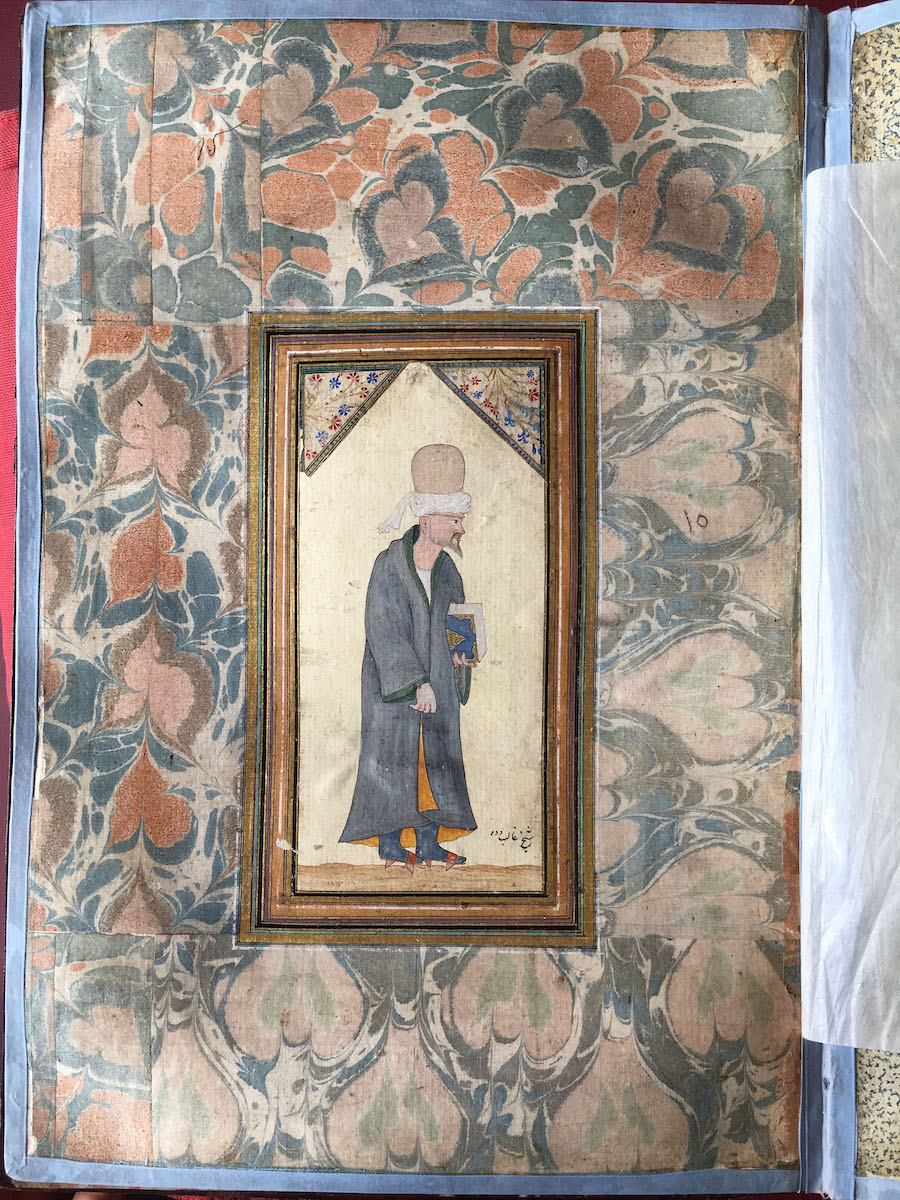
Fig. 20. Artist(s) unknown, “Sheikh Galib Dede,” late 17th-early 18th century. Opaque watercolor on paper, 34 x 24 cm. Bibliothèque national de France, Paris, Arabe 6075, fol. 15r. Source gallica.bnf.fr / BnF.
Another substantial group of depictions bridges the divide between courtly and popular culture, as well as literature and politics: historical members of Sufi brotherhoods. Whether the compiler chose these paintings to represent brotherhoods to which he subscribed or merely ones that resonated with his audience, these figures capture the most influential sects operating in Istanbul at the time. For instance, the premier Mevlevi poet of Selim III’s reign, Sheikh Ghalib Dede (d.1799), appears in Arabe 6075 (Fig. 20).[62] During his lifetime, Ghalib Dede garnered the praise and admiration of Selim III, inspiring the Sultan to refurbish the Galata Mevlevihanesi in his honor.[63] Politically, Ghalib Dede had a major role in enhancing the influence of the Mevlevi order at court, thanks in part to the support he provided to Selim III for major reforms including the famous military overhaul called the Nizam-i Cedid (“New Order”).[64]
Ghalib Dede’s poetic reputation suits the nature of these albums remarkably well. His poetic style speaks to the eighteenth-century obsession with “freshness” and “innovation,” also prominent in prose and architectural epigraphy of the period.[65] The Sheikh capitalized on his deft manipulation of Turkic idiom and Persian turns of phrase to create what the poet himself and his later biographers considered to be a truly inventive product.[66] Ghalib Dede describes his own style as such:
I’ve outdistanced my predecessors’ school
I’ve spoken a language with different rules,I did not conform to that company,
Who like Khusraw emulate Nizami.[67]
The poet’s innovation reflects a movement that expanded across poetry and the visual arts during the later eighteenth century. In this album, that theme is already found in painting through the eclectic mix of works available on the market. For Sufi poetry, the way Ghalib Dede wielded language abandoned the classical Ottoman emulation of traditional Persian poetry, which appealed to a wide swathe of non-elite audiences.[68] In that regard, Ghalib Dede’s portrait inhabits the same sphere of popular literary imagination as the characters from tales discussed earlier.
Beyond poetry, Sufis from brotherhoods pictured in these albums engaged in debates that raged on the more mundane level of Ottoman politics and society. In Arabe 6075, one opening articulates the tensions between forms of devout Sufi practice (Figs. 21a and 21b). The first portrait presents a seated, pensive man meditating between two trees, labeled as a leader or “Shah” of the Nakşibendi Sufis. Letters before his feet highlight his erudite nature, possibly indicating the subject of his contemplation. The opposite painting portrays mendicant life through a dervish wearing a rough cloak and carelessly opened garments. He carries a rucksack of flowers in one hand and appears almost to offer a sprig to his reflective neighbor. Labeled as Dervish Siyah Şamr-ı Kom, this figure creates a stark contrast with the Nakşibendi leader. Even the background of the dervish immediately seems desolate with its smattering of bare and aging foliage, particularly in comparison to the graceful trees that frame the Nakşibendi shaykh, who is biting his finger in astonishment at the unseemly appearance of his counterpart. Their disparate visions of Sufism work in tandem to invite the viewer to consider the nature of mystical devotion.
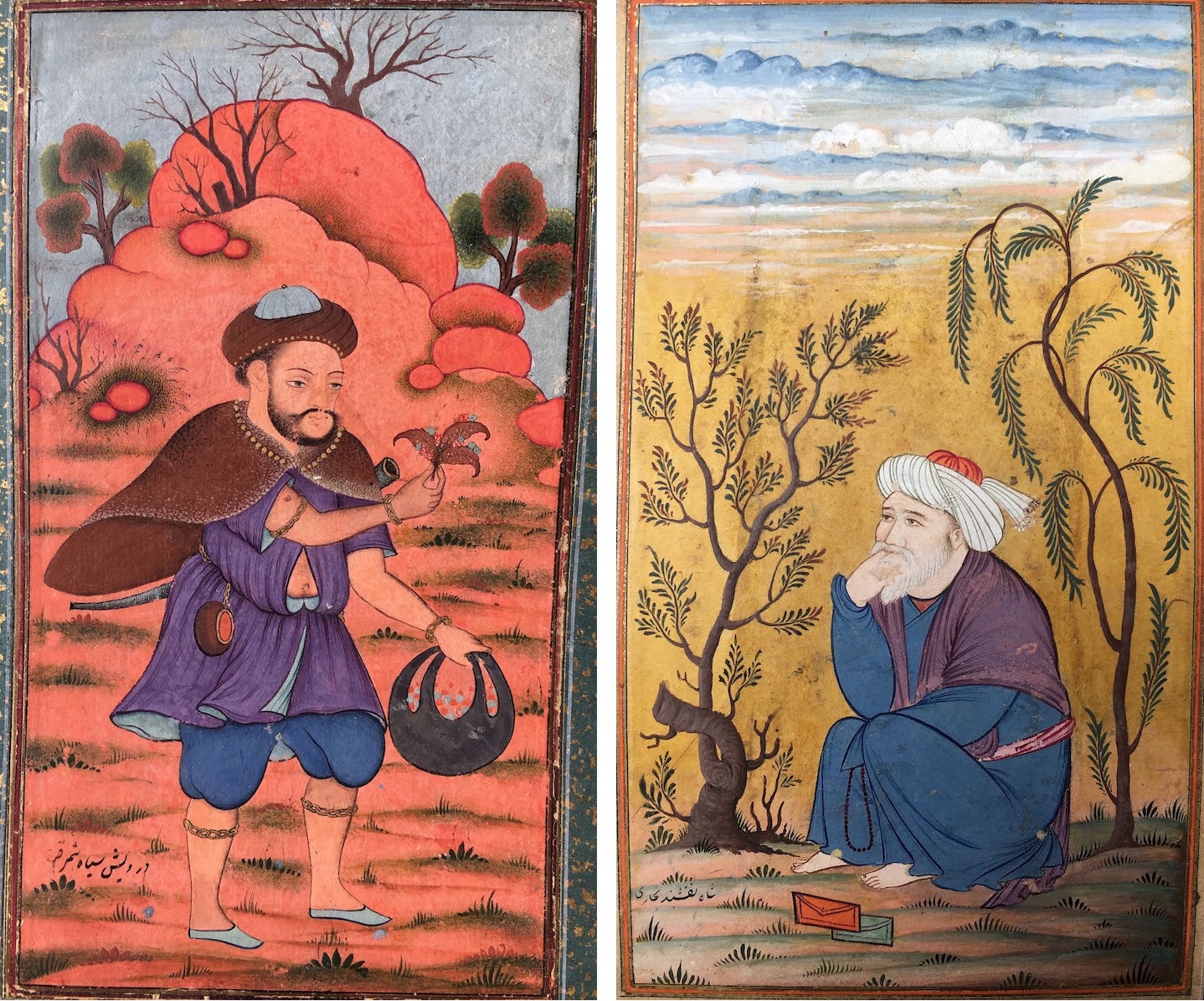
Figs. 21a and 21b. Artist(s) unknown, “Derviş Siyah Şamr-ı Kom” and “Şah-ı Nakşibendi-yi Buhari,” early to mid 18th century. Opaque watercolor on paper, 34 x 24 cm. Bibliothèque national de France, Paris, Arabe 6075, fol. 6b-7a. Source gallica.bnf.fr / BnF.
Such juxtapositions touch on critiques lodged by Sufis against fellow practitioners since the sixteenth century, when prominent mystical orders consolidated in the Ottoman Empire.[69] However, by the time these albums were bound in the late eighteenth century, this tension between institutionalized Sufism and dervish practice became increasingly pronounced due to the close relationship between the Ottoman ruling elite and the Nakşibendi-Muceddidi order to which our pictured thinker belonged.[70] Sufi orders like the Bektaşis, who had strong roots in dervish mysticism, critiqued these learned men in their canonical texts and contemporary discourse.[71] Thus the opening alludes to that friction between these forms of faith, relevant to eighteenth-century audiences in new but equally significant ways. Orders like the Bektaşis had a distinct role in Ottoman urban politics due to their connections to the janissary corps.[72] Therefore, they found themselves at odds with the learned Sufi bloc of Mevlevis and Nakşibendi-Muceddidis, who supported military reforms like the aforementioned Nizam-i Cedid, which threatened janissary status with new armed forces.[73]
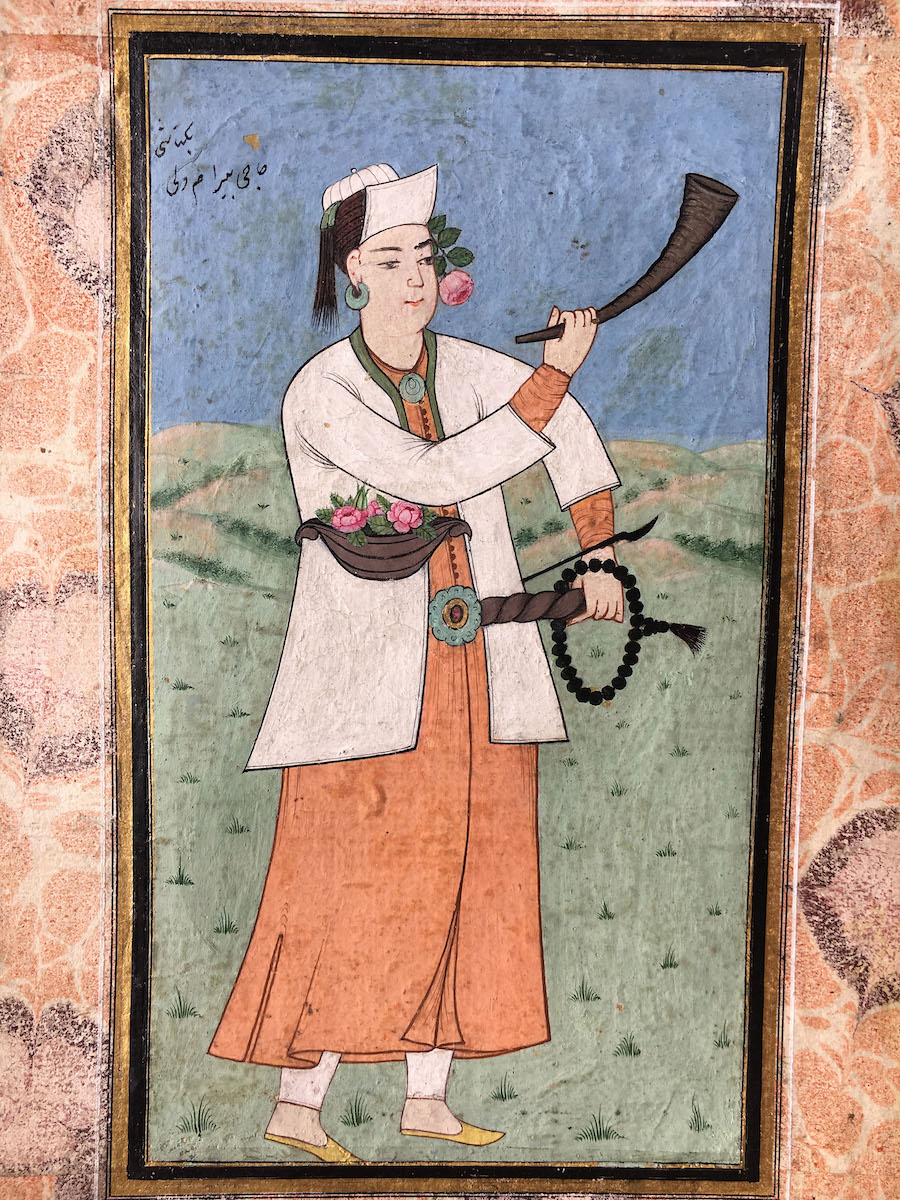
Fig. 22. Artist(s) unknown, “Haci Bayram Veli Bektaşi,” first half of 18th century with later 18th-century additions. Opaque watercolor on paper, 34 x 24 cm. Bibliothèque national de France, Paris, Arabe 6077, fol. 9r. Source gallica.bnf.fr / BnF.
The compiler of this trilogy demonstrates a keen interest in Bektaşi practice by including several characters from their canon throughout the albums. In Arabe 6077, the founder of the order, Haci Bayram Veli Bektaşi (d.1271) appears on a grassy meadow (Fig. 22).[74] Painted in the early eighteenth century, he wears a headdress adorned with roses, while his arms carry accessories of devotion, including prayer beads, a flower basket, and a horn. Another bifolio opening in Arabe 6077 reveals early Bektaşi figures like Seyyid Ali Sultan with a horn in hand (Figs. 23a and 23b). Also known as Kızıldeli Sultan (d. 1402), this early Ottoman dervish aided the Turks in colonizing Anatolia.[75] Across from him stands the Bektaşi poet Hazret-i Virani Sultan. Folio 13v of Arabe 6075 also includes a “Genc Abdal,” or dervish with a horn. The concentration of such figures raises the possibility that the owner/compiler was a Bektaşi himself, or perhaps catered towards this group as a sympathizer or performer. These characters survived in popular stories well into eighteenth century, recited in hagiographic tales (menakıbnames) like the Battalname or Vilayetname, canonical texts for Bektaşi practice.[76] The combination of adventure, wonder, and spiritual exemplars made these works ideal for nightly entertainments as well as didactive purposes. A new follower of the order (mürid) could continuously listen to such hagiographic tales recounted in episodic storytelling at these gatherings.[77]
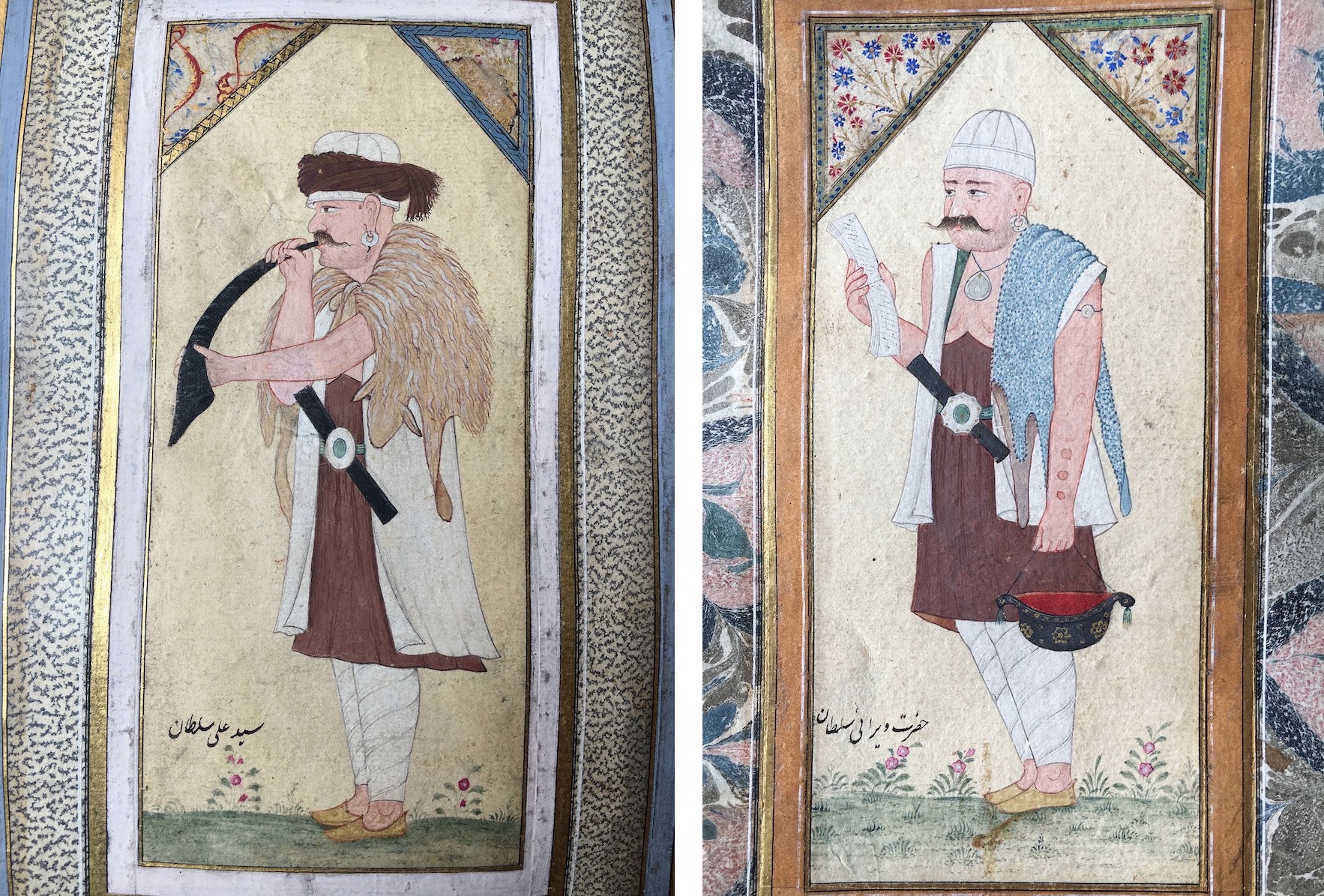
Figs. 23a and 23b. Artist(s) unknown, “Seyyid Ali Sultan” and “Hazret-i Virani Sultan,” late 17th-early 18th century. Opaque watercolor on paper, 34 x 24 cm. Bibliothèque national de France, Paris, Arabe 6077, fol. 3v-4r. Source gallica.bnf.fr / BnF.
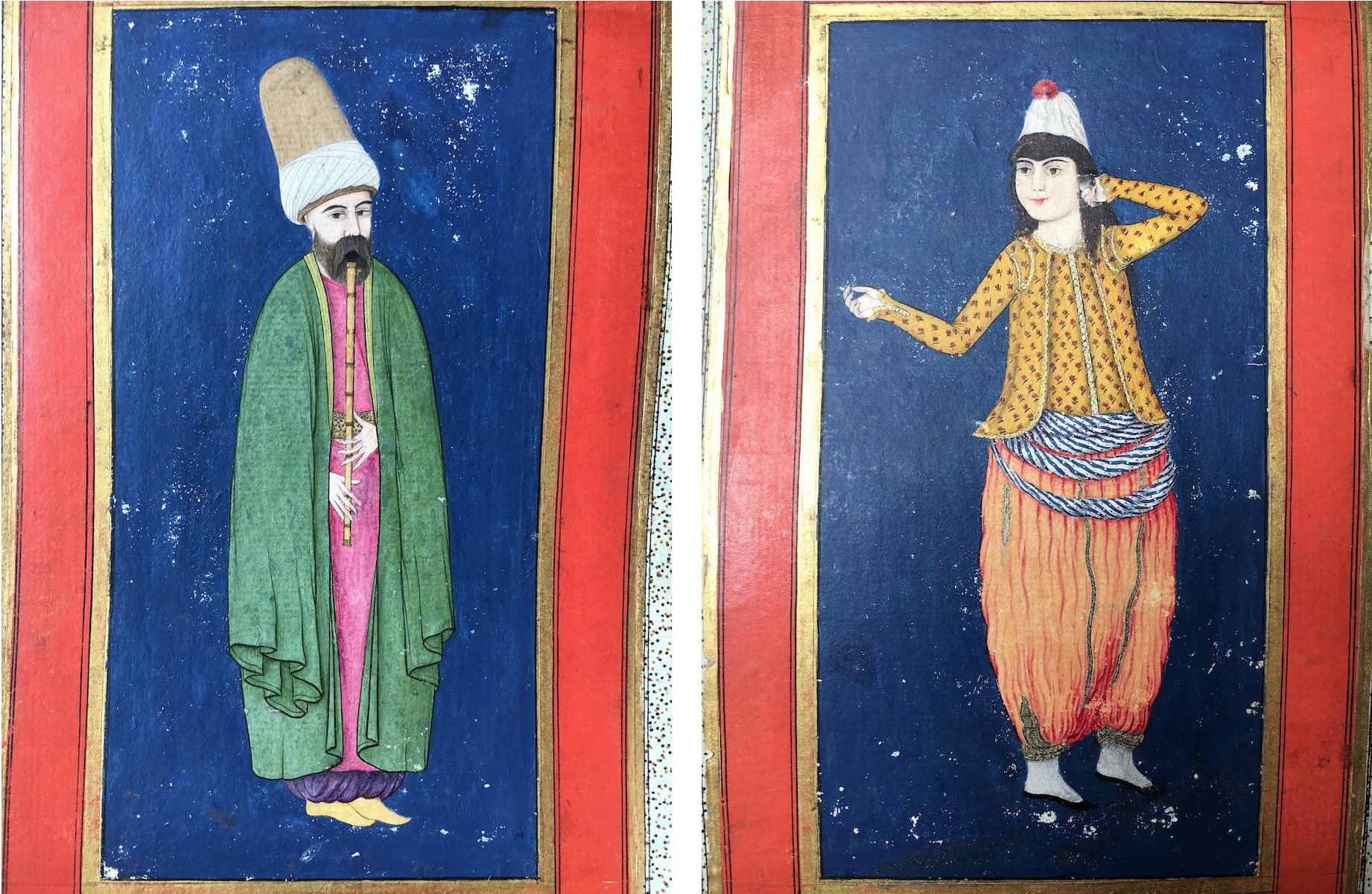
Figs. 24a and 24b. Artist(s) unknown, Portrait of a ney player and Portrait of a performer of a meyhane, late 18th century. Opaque watercolor on paper, 34 x 24 cm. Bibliothèque national de France, Paris, Arabe 6075 fol. 12v-13r. Source gallica.bnf.fr / BnF.
One bifolio opening alludes to other social spaces in which an audience could have encountered performances of these stories and an array of literary tales (Figs. 24a and 24b). Within it, a young performer glances, gesturing as if in response to the ney player across the gutter. Perhaps once belonging to a now-lost text, a şehrengiz poem or even an improvised work, these two decontextualized characters often inhabited the same social sphere of leisurely entertainment and storytelling offered in coffeehouses or meyhanes, as portrayed in the Hubanname ve Zenanname (IUK T. 5502) (Fig. 25). Fittingly, this pair also brings up the question of performance and how these albums may have functioned. The potential use of paintings in poetic recitations has emerged from several studies on marketplace albums of diverse sizes and qualities alongside scattered historical references to paintings in literary settings.[78] Any engagement with this trilogy likely occurred on an intimate level, a small gathering like a meclis or garden party, especially since a given album could support an audience of no more than a handful of people,[79] which surviving illustrations support (Fig. 26).[80] Especially because these albums had a role in crafting the owner’s sense of identity, it is difficult to imagine that they were not shared at some point. Albums were no less socially strategic than clothing or lavish home furnishings as modes of consumerism and, once viewed, they had the potential to convey powerful statements regarding their owner.
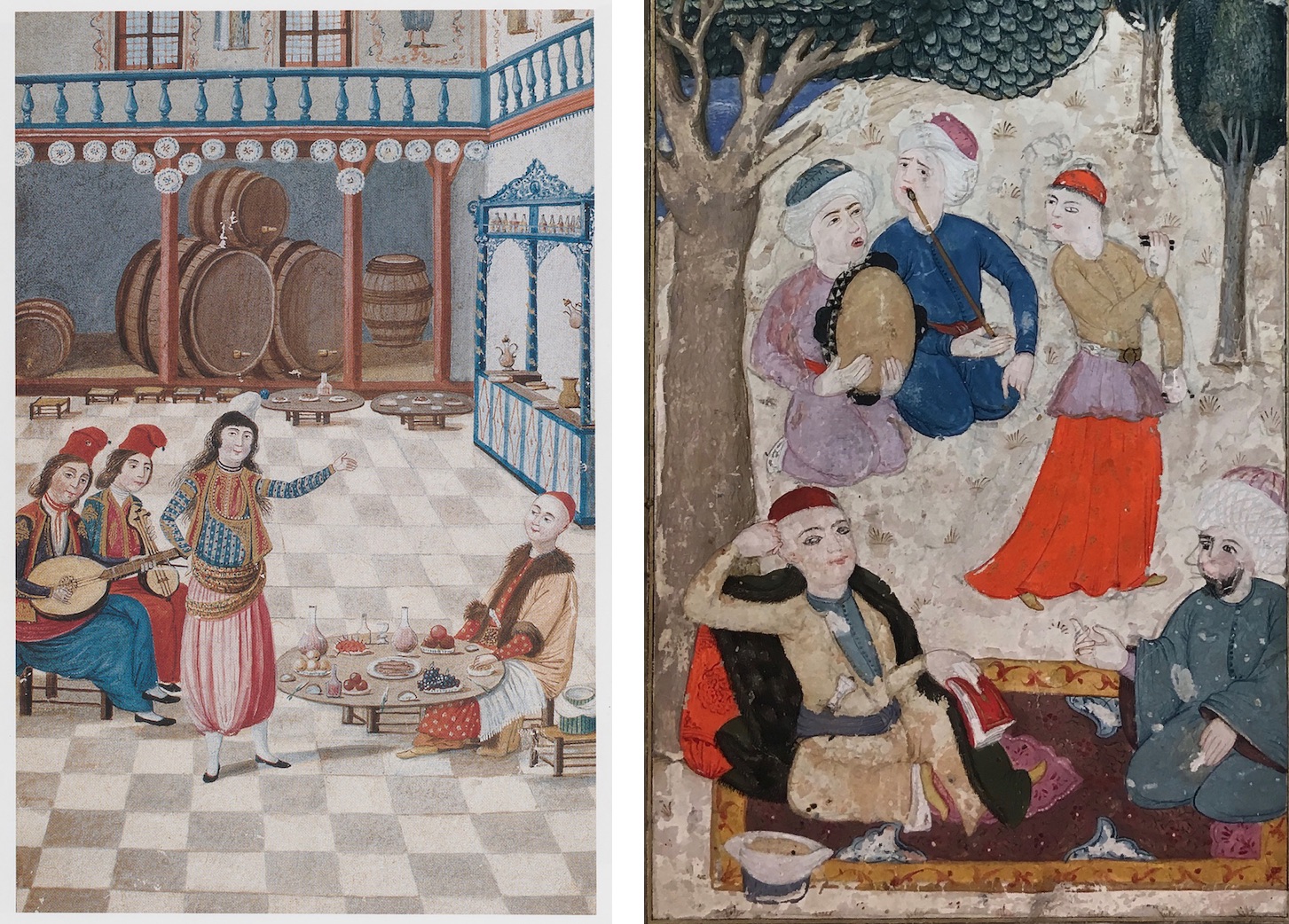
LEFT: Fig. 25. Artist(s) unknown, Detail of an entertainer with a customer at a meyhane, from Fazıl Enderûnî’s “Hubanname ve Zenanname,” late 18th century. Opaque watercolor on paper, 17 x 7.8 cm. IUK, Istanbul, (T. 5502), fol. 41a. Image courtesy of Istanbul University.
RIGHT: Fig. 26. Attributed to Levni (likely erroneous), Detail of “Meclis of a Çelebi” (one member holds a red, mecmua-like book), c. 1720-1730. Opaque watercolor on paper. Museum für Islamische Kunst, Berlin, Nr. 1.28.75c. © Museum für Islamische Kunst SMB.
Conclusion
The BnF trilogy attests to the eclectic, experimental nature of the urban art market in late eighteenth-century Istanbul. Fueled by a range of source material, Ottoman artists responded to their predecessors and contemporaries abroad with a spread of portraits that captured the eyes of their cosmopolitan clientele. While these works shed light on some key aspects of the urban art market, they invite more questions about modes of market circulation and the manifold ways a painting could arrive in the hands of a collector. In doing so, the albums oblige scholars to look beyond the initial patronage favored by the court, to consider more closely the appeal and availability of second-hand and refurbished works. Even the later paintings of stylish men and women, created entirely during the late eighteenth century, raise further questions to pursue, especially regarding whether we can consider such works ready-to-buy art in the same sense as earlier “costume album” portraits. Although they are seemingly higher-end products, the paintings in this trilogy also acted as commodities onto which a purpose (and identity) were imposed by their inscriptions, arrangement, and binding.
Moreover, the ways in which this trilogy’s paintings interacted with stylistic developments from the wider Persianate world shed additional light on the preferences of buyers during this period. Numerous acem and hindi (Persian and Indian) objects appear in the inheritance registers of well-to-do urbanites during the eighteenth century.[81] It is possible that these albums offered one means of feeding that trend with its foreign paintings and portraits that integrated elements of Persian and European production. Their aesthetics of eclecticism and material engagement with the past also resonate with noted developments in Mughal and Safavid albums from the same era.[82] Therefore, the BnF trilogy helps situate the Ottomans within these artistic movements that contributed to wider Persianate exchange during the eighteenth century.[83] The production and compilation practices seen here reflect an extensive set of cultural innovations spurred by increasingly broad participation in international trade networks and the local bazaar economy. As an avenue for further study, these albums elicit substantial questions about the cross-cultural applicability of the market dynamics seen here, perhaps due to the very trade circuits that contributed to their creation.
In the sphere of Ottoman studies, the BnF trilogy presents a veritable repertoire through which scholars can trace the reception of popular literature in single-leaf, visual media. The owner’s inscriptions preserved within their pages act as a significant key to unlocking and recreating the urban stories around each pair of otherwise anonymous figures. Yet this trilogy of albums tells stories not only of Istanbul, but also of an individual who navigated its bazaar in search of painted treasures. Our nameless compiler was no royal, and yet he possessed not only the wherewithal to acquire an impressive array of single-page works, but also the knowledge necessary to curate those images into a poignant set of narratives that embodied the concerns of the urban elite. The BnF compilations celebrate the market’s offerings as signifiers of their owner’s deep understanding of Istanbul’s art scene, as well as its literary and political world. Their intimate displays of conspicuous consumption allowed the popular landscape of the compiler’s imagination to endure—even though his name did not.
Gwendolyn Collaço is a joint PhD candidate in History of Art & Architecture and Middle Eastern Studies at Harvard University
Acknowledgements: My deep thanks to Nebahat Avcıoğlu for this opportunity and to my two anonymous reviewers for their thoughtful feedback and comments. I was fortunate and grateful to have the Frederick Sheldon Traveling Fellowship while researching these albums. I thank the Orient-Institut, Istanbul for their support as a fellow while I wrote this article.
[1] This use of the term “conspicuous consumption” stems from Peter Burke’s work on early modern Italy, and has since been adopted for comparative studies in other polities, including the Ottoman Empire and the Qing Empire in China. Peter Burke, The Historical Anthropology of Early Modern Italy: Essays on Perception and Communication (Cambridge: Cambridge University Press, 1987), 5-7, 132-149. For the Ottoman and Qing application of the term, see Elif Akçetin and Suraiya Faroqhi, “Introduction,” in Living the Good Life: Consumption in the Qing and Ottoman Empires of the Eighteenth Century, ed. Akçetin and Faroqhi (Leiden: Boston: Brill, 2018), 1-38; at 6.
[2] The albums are untitled and do not include any dates. The trilogy belongs to a group of manuscripts originally from the collection of Charles-Henri-August Schefer (d. 1898), a French orientalist and scholar. Schefer acquired his impressive collection of manuscripts both as purchases and gifts from collectors and bibliophiles during his tenure abroad as a drogman-chancelier (dragoman chancellor) working in Jerusalem, Izmir, Alexandria, and finally Istanbul. See Frances Richard, “Quelques collectionneurs français de manuscrits persans au XIXème siècle,” Luqman 10:1 (1993-1994), 64-65. The reason why the albums are marked as “Arabe” is unknown, but two main possibilities emerge: They may have been purchased from an Arab vendor during Schefer’s travels to these regions, or the initial cataloguer misidentified the sparse annotations in the albums as Arabic. This latter option is likely, since all other books in the Schefer Collection were originally catalogued by language of text, not place of origin. Also, the later notes pasted into these albums likely are in Arabic based on the vowel marks in two out of three of the albums, but this is an addition by a later seller/owner and does not match the original hand within the pages of the albums, whose character labels place the time of compilation in the late eighteenth century. The Arabic-script folio numbers may date to the original owner, though it is difficult to say for certain. The folio numbers in a European hand were added after the albums reached the BnF.
[3] Peter Mundy, The Travels of Peter Mundy in Europe and Asia: 1608–1667, vol. 1, ed. R.C. Temple (Cambridge: Cambridge University Press and The Hakluyt Society, 1907), 27. See also Filiz Adiguzel Toprak, “1618 Tarihli ‘Peter Mundy’ Albumu: Figurler Uzerine bir Inceleme,” Sanat Dergisi 22 (2012), 69-83; and Gwendolyn Collaço, “Dressing a City’s Demeanour: Ottoman Costume Albums and the Portrayal of Urban Identity in the Early Seventeenth Century,” Textile History 48: 2 (Nov 2017), 248-267. For a detailed discussion of one of the illustrated mecmua see Tülün Değirmenci, “An Illustrated Mecmua: The Commoner’s Voice and the Iconography of the Court in Seventeenth-Century Ottoman Painting,” Ars Orientalis 41 (2011), 186-218.
[4] Roxburgh, The Persian Album, 1400-1600: From Dispersal to Collection (New Haven: Yale University Press, 2005), 11.
[5] Among the studies below, the longest analysis of one of these albums comes from a scholar outside of Ottoman studies in a brief comparative discussion of ethnographic albums. See Laura Hostetler, “Introduction; Early Modern Ethnography in Comparative Historical Perspective,” in David Deal and Laura Hostetler, eds., The Art of Ethnography: A Chinese “Miao Album” (Seattle: University of Washington Press, 2006), xvii-lxvii; especially lv. See also Serpil Bağcı, “Levni,” in The Grove Encyclopedia of Islamic Art and Architecture, vol. 2, ed. Jonathan Bloom and Sheila Blair (Oxford; New York: Oxford University Press, 2009), 420; Massumeh Farhad, Safavid Single Page Painting, 1629-1666 (PhD dissertation, Harvard University, 1987), 170; and Serpil Bağcı, “The Ottomans in Diez’s Collection,” in The Diez Albums: Contexts and Contents, Julia Gonnella et al., eds., (Leiden: Brill, 2017), 613-638.
[6] These character inscriptions are discussed in greater detail in the author’s forthcoming dissertation.
[7] While I do not preclude the possibility that the original compiler/owner was female, recent studies based on royal women have shown that far fewer women had books listed on their inheritance registers, and that their library endowments drew from general palace collections. See Tülay Artan, “Problems Relating to the Social History Context of Acquisition and Possession of Books as Part of Collections of Objets d’Art in the 18th Century”, Proceedings of the 10th International Congress of Turkish Art, 17-23 September 1995 (Geneva: Fondation Max Van Berchem, 1999) 87-92; at 90-91, who in turn cites İsmail Erünsal, Türk Kütüphaneleri Tarihi, vol. 2 (Ankara: Türk Kütüphaneleri Tarihi, 1992), 69, 126, 175, 203. When women did own manuscripts, more often these fell into the genre of prayer books such as the Delailü’l Hayrat. For more on this genre and its uses during this period, see Sabiha Göloğlu, “Linking, Printing, and Painting Sanctity and Protection: Representations of Mecca, Medina, and Jerusalem in Late Ottoman Illustrated Prayer Books,” in The Miraj of the Prophet and Stations of His Journey, ed. Ayşe Taşkent and Nicole Kançal-Ferrari (Ankara: Turkish Ministry of Culture; Independent Art Foundation, forthcoming). See also Göloğlu’s forthcoming dissertation “Eighteenth- and Nineteenth-Century Representations of the Islamic Pilgrimage and Visitation Sites in the Ottoman Empire” (PhD dissertation, Koç University, 2018).
[8] By using the term “portraits” in this article, I refer to the owner’s reception of these works, as their inscriptions made these paintings identifiable characters and historical figures. I acknowledge that in production the artists may not have modeled the paintings themselves off of a specific individual.
[9] Suraiya Faroqhi, “Research on the History of Ottoman Consumption: A Preliminary Exploration of Sources and Models,” in Donald Quataert, ed., Consumption Studies and the History of the Ottoman Empire, 1550-1922: An Introduction (Albany: SUNY Press, 2000), 15-44; and Akçetin and Faroqhi, Living the Good Life.
[10] Terekat (inheritance registers) help to outline painting collections of urban Ottomans, inventoried as musavver (“illustrated”) books. For a published selection, see İsmail E. Erünsal, Osmanlılarda Sahaflık ve Sahaflar (Istanbul: Timaş Yayınları, 2013), 453-459.
[11] Tülay Artan, “A Composite Universe: Arts and Society in Istanbul at the End of the Eighteenth Century,” in Michael Hüttler et al., eds., Ottoman Empire and European Theatre (Vienna: Don Juan Archiv Wien Forschungsverlag, 2013), 776-777. For more on Ottoman wall paintings, see Günsel Renda, Batılılaşma Döneminde Türk Resim Sanatı 1700-1850 (Ankara: Türk Tarih Kurumu Basımevi, 1977), 77-98.
[12] Artan’s discussion of conspicuous consumption covers numerous personal effects, including food, clothes, prints, and manuscripts like these. She also notes a striking similarity of belongings listed in probate registers for people of different social classes during this period. Artan, “Problems Relating to the Social History Context,”10ème Congrès international d’Art turc, 87-92. See also Tülay Artan, “Aspects of the Ottoman Elite’s Food Consumption: Looking for ‘Staples,’ ‘Luxuries,’ and ‘Delicacies’ in a Changing Century,” in Quataert, ed., Consumption Studies, 107-200.
[13] Courtly albums and royal patronage received substantially more attention in scholarship. For Ottoman cases, see Serpil Bağcı, “Presenting Vaṣṣal Kalender’s Works: The Prefaces of Three Ottoman Albums,” Muqarnas 30 (2014), 255-313; Emine Fetvacı, “The Album of Ahmed I,” Ars Orientalis 42 (2012), 127-139; Aimee Froom, “A Muraqqa for the Ottoman Sultan Murad III (r.1574-1595): Osterreichische Nationalbibliothek Codex Mixtus 313” (PhD dissertation, Institute of Fine Arts, New York University, 2001). For background on the development and interpretation of albums in the wider Persianate tradition, particularly as it relates to art historical consciousness, see Roxburgh, The Persian Album, 483-499.
[14] Metin And, “17. Yüzyıl Çarşı Ressamları,” Tarih ve Toplum 3 (1985), 40-45; Leslie M. Schick, “Ottoman Costume Albums in a Cross-Cultural Context,” in 10ème Congrès international d’Art turc, 625. For festival gifts, see Banu Mahir, “A Group of 17th-Century Paintings Used for Picture Recitation,” in 10ème Congrès international d’Art turc, 433-55; 449.
[15] Similar historiographic issues are also noted for architecture of the period; see Shirine Hamadeh, “Westernization, Decadence and the Turkish Baroque: Modern Constructions of the Eighteenth Century,” Muqarnas, 24 (2007), 185-197; especially at 194. For background on the historiographic emphasis placed on Westernization in Ottoman painting, see Günsel Renda, Batılılaşma Döneminde Türk Resim Sanatı 1700-1850 (Ankara: Türk Tarih Kurumu Basımevi, 1977). See also Renda et al., A History of Turkish Painting (Geneva: Palasar and University of Washington Press, 1988).
[16] Bahattin Yaman, Osmanlı Saray Sanatkârları: 18. yüzyılda Ehl-i Hiref (Istanbul: Tarih Vakfı Yurt Yayınları: 2008), 51; Yaman, “Sarayın Sanatkarları: 18. Yüzyıl Osmanlı Ehl-i Hiref Teşkilatı,” in XV. Türk Tarih Kongresi, 11 – 15 Eylül 2006, IV. Cilt, IV. Kısım (Ankara: Türk Tarih Kurumu Basımevi, 2010), 1941.
[17] The past decade has produced a number of compelling studies concerning both localized and cross-cultural art markets, including but not limited to Sandra van Ginhoven, Connecting Art Markets: Guilliam Forchondt’s Dealership In Antwerp (c. 1632-78) and the Overseas Paintings Trade (Leiden: Brill, 2017); Thomas Bayer and John Page, The Development of the Art Market in England: Money as Muse, 1730-1900 (London: Pickering & Chatto, 2011); and N. De Marchi and H. J. Van Miegroet, eds., Mapping Markets for Paintings in Europe, 1450–1750 (Turnhout, Belgium: Brepols, 2006).
[18] Thanks to Jake Benson for his guidance in dating these bindings and marbled papers. See similar marble patterns in the pastedowns of Topkapı album H. 2143, compiled during the last quarter of the eighteenth century.
[19] “ḳıṭ‘a-yı ‘aded-i ۳۰.” Meaning “part of a total of 30,” the most logical reference is to the number of paintings, though there is a chance it refers to number of volumes. However, no other volumes matching the bindings, supports, and dimensions of these three codices have surfaced so far.
[20] Adam Gacek, Arabic Manuscripts: A Vademecum for Readers (Leiden: Brill, 2009), 27-28. This binding is common for cheaper, shorter albums, like Süleymaniye Library 02954, and İstanbul Araştırma Enstitüsü, ŞR 251, a mid-eighteenth-century mecmua.
[21] Jake Benson, “Satisfying an Appetite for Books: Innovation, Production, and Modernization in Later Islamic Bookbinding,” in Kamran Talattoff, ed., Persian Language, Literature, and Culture: New Leaves, Fresh Looks (London: Routledge, 2015), 366-367.
[22] Annie Berthier, “Un aspect de reliure turque: le papier marbré (d’après le fonds turc de la Bibliothèque National),” Revue Française d’Histoire du Livre 37 (1982), 605–620.
[23] TSMK, H. 2145, H. 2143, H. 2155.
[24] Zeynep Çelik Atbaş, “Topkapı Sarayı Müzesi Kütüphanesi’ndeki H. 2155 Numeralı Murakka” (MA thesis, Mimar Sinan Üniversitesi, 2003), 11-16. See also Zeynep Çelik Atbaş, “Osmanlı Aydını Mehmed Emin Efendi ve Murakkaları,” in Frédéric Hitzel, ed., 14th International Congress of Turkish Art: Proceedings (Ankara: Ministry of Culture and Tourism), 117-126.
[25] Benson, “Later Islamic Bookbinding,” 368-369.
[26] Shirine Hamadeh, The City’s Pleasures: Istanbul in the Eighteenth Century (Seattle: University of Washington Press, 2008), 109.
[27] TSMK, H. 2143, H. 2155, Y.Y. 1042, 1043, and 1086. Bukhari and Levni are known for their depictions of women and contemporary costume. Nancy Micklewright, “‘Musicians and Dancing Girls’: Images of Women in Ottoman Miniature Painting,” in Madeline Zilfi, ed., Women in the Ottoman Empire: Middle Eastern Women in the Early Modern Era (Leiden: Brill, 1997), 161-162. Banu Mahir, “Abdullah Buhari’nin Minyatürlerinde 18. Yüzyılı Osmanlı Kadın Modası,” P Sanat, Kültür, Antika 12 (1998), 70-81.
[28] A. Sakisian, “Le Peinture à Constantinople et Abdullah Boukhari, impressionist turc du XVIII siècle,” Revue de l’Art ancient et modern 54 (1928), 200.
[29] Sakisian, “Abdullah Boukhari,” 198. Renda, Batılılaşma, 41-42. Serpil Bağcı et al., Ottoman Painting (Ankara: Republic of Turkey, Ministry of Culture and Tourism, 2010), 267.
[30] Antoine Galland, Journal d’Antoine Galland pendant son Séjour a Constantinople, 1672-1673, vol. 1 (Paris: Librarie de la Société Asiatique, 1881), 67 and 37 for a location reference. Though Galland does not always list the exact location of manuscript sales, most logical place is in the Sahaflar Çarşısı or Second-Hand Book Market. See: Erünsal, Sahaflık ve Sahaflar. However, Galland also mentions a high-end book sale occurring in the Bedestan, the multi-domed section of the covered market (kapalı çarşı) where most precious textiles, metalwork and jewelry were sold.
[31] Hedda Rieindl-Kiel, “Der Duft der Macht Osmanen, islamische Tradition, muslimische Mächte und der Westen im Spiegel diplomatischer Geschenke,” Wiener Zeitschrift für die Kunde des Morgenlandes 95 (2005), 231-232.
[32] David Roxburgh, “Heinrich Friedrich von Diez and His Eponymous Albums: Mss. Diez A. Fols. 70-74,” Muqarnas 12 (1995), 112-136, nos. 19-20.
[33] Beshara Doumani, Family Life in the Ottoman Mediterranean: A Social History (Cambridge: Cambridge University Press, 2017), 11-14.
[34] Kadızadelis were fundamentalist followers of Kadızade Mehmed (d. 1635), who served as the preacher of Hagia Sophia mosque for a time. They opposed innovation (bida), Islamic mysticism (Sufism), and popular religion generally. Madeline Zilfi, “The Kadızadelis: Discordant Revivalism in Seventeenth-Century Istanbul,” Journal of Near Eastern Studies 45:4 (1986), 251-269.
[35] Robert Dankoff, trans., Evliya Çelebi in Bitlis: The Relevant Section of the Seyahatname (Leiden: Brill, 1990), 294-295.
[36] Dankoff, Evliya in Bitlis, 293-295.
[37] Illustrated mecmua/murakka prices range from 350 kuruş to 2,100 akçe. Erünsal, Sahaflık ve Sahaflar, 453-459.
[38] Sussan Babaie, “Shah ‘Abbas II, the Conquest of Qandahar, the Chihil Sutun, and Its Wall Paintings,” Muqarnas 11 (1994), 131 and figs. 11-12. See also Parviz Tanavoli, European Women in Persian Houses: Western Images in Safavid and Qajar Iran (London: I.B. Tauris, 2015), 21-23 and 60-67. Eleanor Sims and Ernst Grube, “Wall Paintings in the Seventeenth-Century Monuments of Isfahan,” in Renata Holod, ed., Studies on Isfahan, Iranian Studies 7 (Boston Society for Iranian Studies, 1974), 511-542.
[39] Oxford, Bodleian Library, Ouseley 297, fol. 1r-2r. Ouseley’s travel account narrates his route back from India, which takes him through Shiraz, Isfahan, and Tabriz before reaching Constantinople and Smyrna. William Ouseley, Travels in various countries of the East, vols. 2 and 3 (London: Rodwell and Martin, 1823).
[40] While also mentioned in the works cited in n. 37, a more focused discussion on the topic of Armenians and artistic exchange is found in Amy Landau, “From the Workshops of New Julfa to the Court of Tsar Aleksei Mikhailovich,” in Venetia Porter et al., Metalwork and Material Culture in the Islamic World: Art, Craft and Text: Essays Presented to James W. Allan (London: I.B. Tauris, 2012), 413-426. See also the dissertation by the same author, Amy Landau, “Farangi-Sazi at Isfahan: The Court Painter Muhammad Zaman, The Armenians of New Julfa and Shah Sulayman” (Phd dissertation, University of Oxford, 2007), 199-218.
[41] Examples from Istanbul include Sadullah Paşa Yalısı and Kavafyan Konağı. Renda, Batılılaşma, 108-168.
[42] Amanda Phillips, Everyday Luxuries: Art and Objects in Ottoman Constantinople, 1600-1800 (Berlin: Staatliche Museen zu Berlin, Verlag Kettler, 2016), 125-127.
[43] Diez (owner), Costumes Turcs, tome II. London, British Museum, 1974,0617,0.12.2, fols. 30, 36, and 41.
[44] IUK, T 5502, Hubânnâme ve Zenânnâme, fol. 78a.
[45] Avner Wishnitzer, Reading Clocks Alla Turca (Chicago: University of Chicago Press, 2015), 33-37, 40.
[46] Zeren Tanında, “Additions to Illustrated Manuscripts in Ottoman workshops,” Muqarnas 17 (2000), 147-161.
[47] In Figures Naturelles de Turquie par Raynal, 1688. BnF, Paris, 4-OD-7. See also “Autre Voyageur” on fol. 36r, and also see the seated “Deviche d’Europe” on fol. 30r for a comparison of a scenic background from the late seventeenth century and another close rendering of the nose and eyes.
[48] H.G. Majer, “Individualized sultans and sexy women. The works of Musavvir Huseyin and their East-West Context,” in in 10ème Congrès international d’Art turc, 463-472; at 466.
[49] Baltimore, Walters Art Museum, Walters MS. 666; Berlin, Museum für Islamische Kunst, I.28.75a-c.
[50] Atbaş, “H. 2155,” fols. 29r and 30r.
[51] Atbaş, 63.
[52] Güner İnal, “Tek Figürden Oluşan Osmanlı Albüm Resimleri,” Ege Üniversitesi Arkeoloji-Sanat Tarihi Dergisi III (1984), 83-96, especially 93-94 and res. 21-24.
[53] For the incarnation of naẓīre in architecture, see Gülru Necipoğlu, “Challenging the Past: Sinan and the Competitive Discourse of Early Modern Islamic Architecture,” Muqarnas 10 (1993), 176-177. For poetry, see Walter Feldman, “Imitatio in Ottoman Poetry: Three Ghazals of the Mid-Seventeenth Century,” Turkish Studies Association Bulletin 21:2 (1997), 42. Walter Andrews, “Starting Over Again: Some Suggestions for Rethinking Ottoman Divan Poetry in the Context of Translation and Transmission,” in Saliha Paker, ed., Translations: (Re)Shaping of Literature and Culture (Istanbul: Boğaziçi University Press, 2002), 15-37. Naẓīre poetry has also been discussed in relation to earlier albums of the seventeenth century. See Emine Fetvacı, “The Gaze in the Album of Ahmed I,” Muqarnas 32 (2015), 145.
[54] For examples of Ottoman prefaces to palace albums see the aforementioned articles by Bağcı, “Presenting Vaṣṣal Kalender’s Works,” and Fetvacı, “The Album of Ahmed I.”
[55] “Tevārīḫ-i Ṭabari [sic] oḳumayub Şāhnāme ve Ḥamzanāme oḳıyan keẕẕāblar.” Nuruosmaniye 4925, f.63a, Develi posits a composition date of late seventeenth to early eighteenth century. Facsimile reproduced in Hayati Develi, ed., Risāle-i Garībe (Istanbul: Kitabevi, 2001), 32, 158.
[56] For a fuller description and history of this genre see Deniz Çalış-Kural, Şehrengiz, Urban Rituals and Deviant Sufi Mysticism in Ottoman Istanbul (Farnham: Ashgate, 2014), 11-12 and throughout.
[57] Cemal Kafadar, “How Dark is the History of the Night, How Black the Story of Coffee, How Bitter the Tale of Love: The Changing Measure of Leisure and Pleasure in Early Modern Istanbul,” in Arzu Öztürkmen et al. eds., Medieval and Early Modern Performance in the Eastern Mediterranean (Turnhout: Brepols, 2014) 261-262.
[58] Ali Duymaz, Kerem ile Aslı Hikayesi: üzerinde Mukayeseli bir Araştırma (Ankara: Kültür Bakanlığı, 2001), 40-78.
[59] Duymaz, 37, 52-53.
[60] Duymaz, 149.
[61] Duymaz, 244-245; Kafadar, “History of the Night,” 251.
[62] Annemarie Schimmel, Mystical Dimension of Islam (Chapel Hill: University of North Carolina Press, 1975), 326.
[63] E.J.W. Gibb, A History of Ottoman Poetry, vol. 4 (London: Luzac, 1905), 176, 179-180.
[64] George W. Gawrych, “Şeyh Galib and Selim III: Mevlevism and the ‘Nizam-i Cedid,’” International Journal of Turkish Studies 4:1 (January 1987), 91-114.
[65] Shirine Hamadeh, “Ottoman Expressions of Early Modernity and the ‘Inevitable’ Question of Westernization,” Journal of the Society of Architectural Historians 63:1 (2004), 33. For further discussion of inscriptions like chronograms and the shift in their thematic topics, see Hamadeh, “The City’s Pleasures: Architectural Sensibility in Eighteenth-Century Istanbul” (Phd dissertation, M.I.T., 1999), 264-269; and Hamadeh, The City’s Pleasures, 171-189.
[66] Gibb, Ottoman Poetry, 176, and 180-183.
[67] “ṭarz-ı selefe taḳḳadum itdim/ bir başḳa luġat tekellüm itdim/ ben olmadım ol gürūha pey-rev/ uymuş beli Gencavi-ye Ḫüsrev.” Şeyh Galib, Beauty and Love, trans. Victoria Rowe Holbrook (New York: Modern Language Association, 2005), 201.
[68] Victoria Rowe Holbrook, “Originality and Ottoman Poetics: In the Wilderness of the New,” Journal of American Oriental Society 112:3 (1992), 440-454.
[69] Ahmet Karamustafa, “Kalenders, Abdâls, Hayderîs: The Formation of the Bektâşîye in the 16th Century,” in Halil Inalcık and Cemal Kafadar, eds., Süleymân the Second and His Time (Istanbul: Isis, 1993), 121-129.
[70] Butrus Abu-Manneh, Studies on Islam and the Ottoman Empire in the 19th Century (1826–1876) (Istanbul: Isis Press, 2001), 7; Artan, “Composite Universe,” 765-766; and Madeleine Zilfi, The Politics of Piety: The Ottoman Ulema in the Postclassical Age (1600–1800) (Chicago: Biblioteca Islamica, 1988).
[71] Kaygusuz Abdal, İkinci Mesnevi, Ankara, Milli Kütüphane, MS. Mil Yz A 7621/2, dated 920/1514, fol. 180-181a. Zeynep Oktay Uslu, “Layers of Mystical Meaning and Social Context in the works of Kaygusuz Abdal,” in A.C.S. Peacock and Sara Yıldız, eds., Islamic Literature and Intellectual Life in Fourteenth- and Fifteenth-Century Anatolia (Würzburg: Orient-Institut Istanbul and Max Weber Stiftung, 2016), 73-100.
[72] Derin Terzioğlu, “Sufis in the Age of State-building and Confessionalization,” in Christine Woodhead, ed., The Ottoman World (Abingdon: Routledge, 2012), 86-102; especially 93.
[73] Artan, “Composite Universe,” 774.
[74] Zeynep Yürekli, Architecture and Hagiography in the Ottoman Empire: The Politics of Bektashi Shrines in the Classical Age (Farnham: Ashgate, 2012), 4.
[75] Ali Yaman and Aykan Erdemir, Alevism-Bektashism: A Brief Introduction (İstanbul: Cem Vakfı, 2006), 25.
[76] Yürekli, Architecture and Hagiography in the Ottoman Empire, 4-6.
[77] Arzu Öztürkmen, “Performance in Late Medieval Turkish Texts: Signs of Orality in Literary and Historical Sources,” in Medieval and Early Modern Performance in the Eastern Mediterranean, ed. Arzu Öztürkmen (Turnhout: Brepols, 2014), 222-225.
[78] Selaniki (d. 1600), cited in Mahir, “Paintings Used for Picture Recitation,” 433-455. See also Değirmenci, “An Illustrated Mecmua.” For connections to literary characters, see Evliya Çelebi, “Esnaf-ı Fālcıyān-ı Musavver,” and “Esnaf-ı Nakkaşān-I Musavvirān,” Seyahatnamesi, I. Kitap, eds. Robert Dankoff et al. (Istanbul: Yapı Kredi, 1999-2007), 313-314.
[79] Roxburgh posits six viewers as the maximum for courtly albums of the Timurid period. Roxburgh, Persian Album, 11.
[80] Phillips, Everyday Luxuries, 114 and 133.
[81] One example with an impressive collection of foreign objects is “The Estate Inventory of Türk Ali Pasha, d. 1700.” See Birol Çetin, “İstanbul Askeri Kassamına âit Hicri: 1112-1113 (M. 1700-1701) Tarihli Tereke Defterleri” (MA thesis, Istanbul University, 1992), 1-31. For a translation into English, see Phillips, Everyday Luxuries, 149-161.
[82] Anastassiia Botchkareva, “Representational Realism in Cross-Cultural Perspective: Changing Visual Cultures in Mughal India and Safavid Iran 1580-1750” (PhD dissertation, Harvard University, 2014), 174-224, especially her discussion of TSMK, H. 2137.
[83] This topic will be a focus of a chapter in the author’s forthcoming dissertation.
Cite this article as: Gwendolyn Collaço, “Albums of Conspicuous Consumption: A Composite Mirror of an 18th-Century Collector’s World,” Issue 6 Albums (Fall 2018), https://www.journal18.org/3089. DOI: 10.30610/6.2018.3
Licence: CC BY-NC
Journal18 is published under a Creative Commons CC BY-NC International 4.0 license. Use of any content published in Journal18 must be for non-commercial purposes and appropriate credit must be given to the author of the content. Details for appropriate citation appear above.
